Jerusalem, the holy city of tears and hopes
Jerusalem is one of the oldest and holiest cities in the world. It is located in the Middle East, surrounded by the Judean Mountains.
The word Jerusalem means a “city of peace” in Hebrew. But for centuries it has been the place of many battles, devastations, and conquests. Everyone wanted to own it and claimed their right to it. Even today, both Israel and the Palestinian Authority claim Jerusalem as their capital.
Jerusalem is situated in a desert without water and natural resources. But it is the holiest city to the three major religions: Judaism, Christianity, and Islam.
I always wondered why exactly this city was chosen to be the centre of the world. What is it about this city that makes people fight for it to the last breath for many centuries? Even when I was walking along its streets I couldn’t understand it.
But, I know that when you visit it, you’re no longer the same person you used to be. Jerusalem simply changes you with its energy and something that you cannot explain to yourself or anyone else.
History of Jerusalem
When we talk about the history of Jerusalem, there are mostly references to events related to the last days of Jesus’ life and his crucifixion. However, the story is much longer and more complicated.
Jerusalem was ruled by many dynasties and kings, such as Canaanites, Israelites, the kings David and Solomon, Persians, Maccabeus, Herodian dynasty, Romans, Crusaders, Mamluk Sultanate, Ottomans, Napoleon, British, modern Zionism… Today it is officially the capital of Israel.
If you are a history fan and want to know more about this fascinating city, I highly recommend the book “Jerusalem: The Biography” by Simon Sebag Montefiore.
Ultimate guide: what to see and visit in Jerusalem
Jerusalem is one of those places where every stone reminds us of history. Wandering its narrow and winding streets you will get to another world.
And, are you familiar with Jerusalem syndrome?
Well, it is a group of various mental phenomena. Actually, some visitors begin to identify with Jesus and other religious figures, read parts of the Bible, sing psalms, and experience enlightenment. Interestingly, the syndrome affects Jews, Christians, and Muslims, as well as those who have no connection with these religions or who have not previously shown signs of any mental problems.
We visited Jerusalem during our Israel tour with the Putnik travel agency in 2017.
Our one-day Jerusalem tour included a visit to the Mount of Olives, the Mount of Zion and the Old City.
So, let’s go for a virtual walk on the ancient path of this holy city until this coronavirus situation stops and until we can travel again!
The Mount of Olives
Opposite the old part of Jerusalem, on the eastern side, there is the Mount of Olives. It got its name after the olive trees that were previously grown on its slopes. During the First and Second Temple periods, the mount was the centre of Jerusalem’s life. But even today has an important role in the pilgrimage sense.
First of all, the Mount is the place of the ascension of Jesus. On the top, there is a little chapel Church of the Ascension, of a rounded shape, on the place of Jesus’ ascension to heaven forty days after his resurrection. Inside there is a slab of stone bearing Jesus’ right footprint he left before he stepped up to heaven.
The church was built in 392 AD, destroyed by Persians in 614 AD, and reconstructed by Crusaders in the 12th century. In 1198, Saladin transformed it into a mosque and added a dome and mihrab. But later, the Ottomans allowed Christians to continue praying here. So they transferred the mosque to a new building made in 1620, close to the chapel. And today the mosque belongs to the Islamic Waqf of Jerusalem.
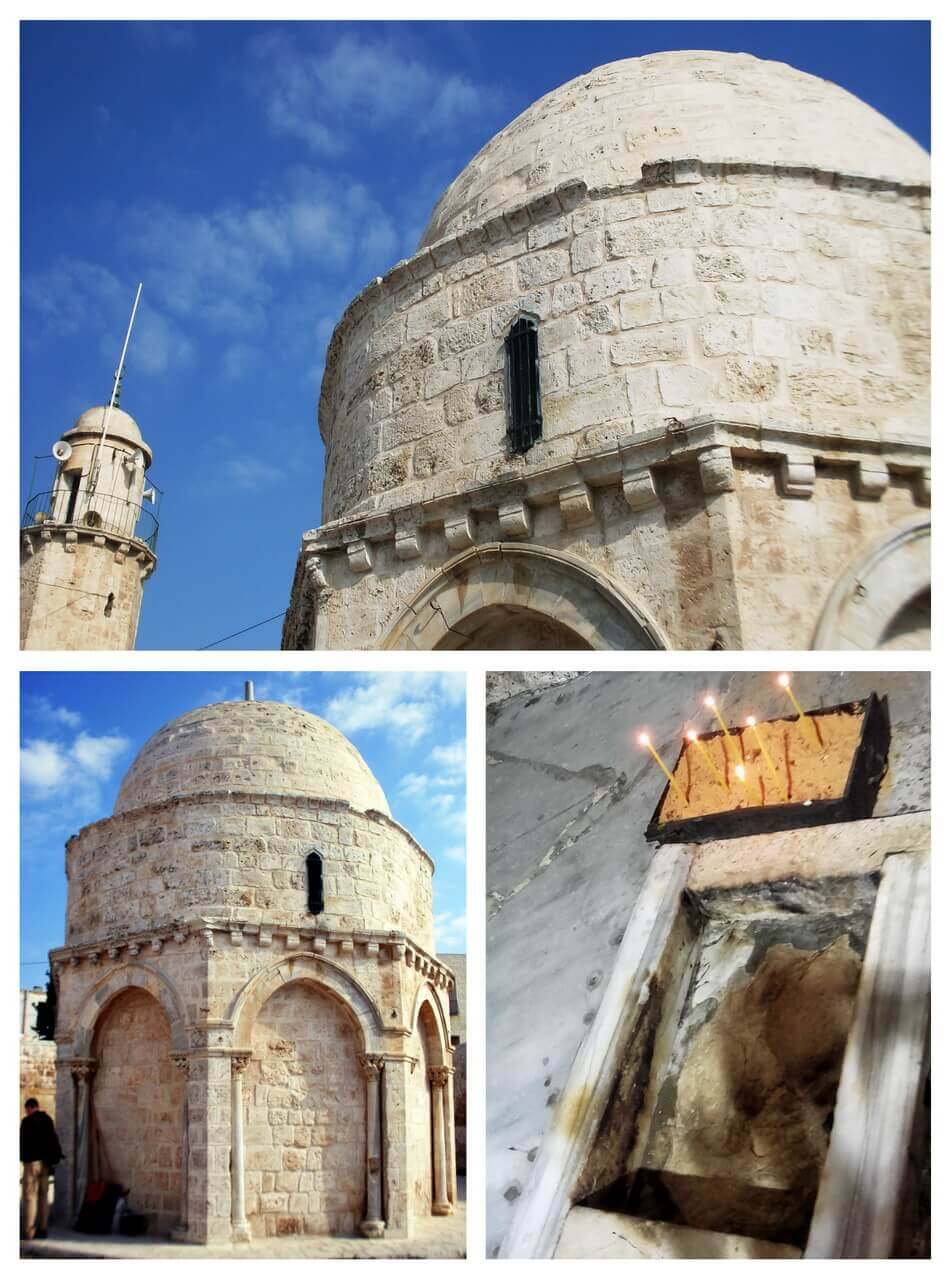
Church of the Ascension on the Mount of Olives
Jewish cemetery
On the Mount of Olives, there is a Jewish cemetery with around 150,000 graves.
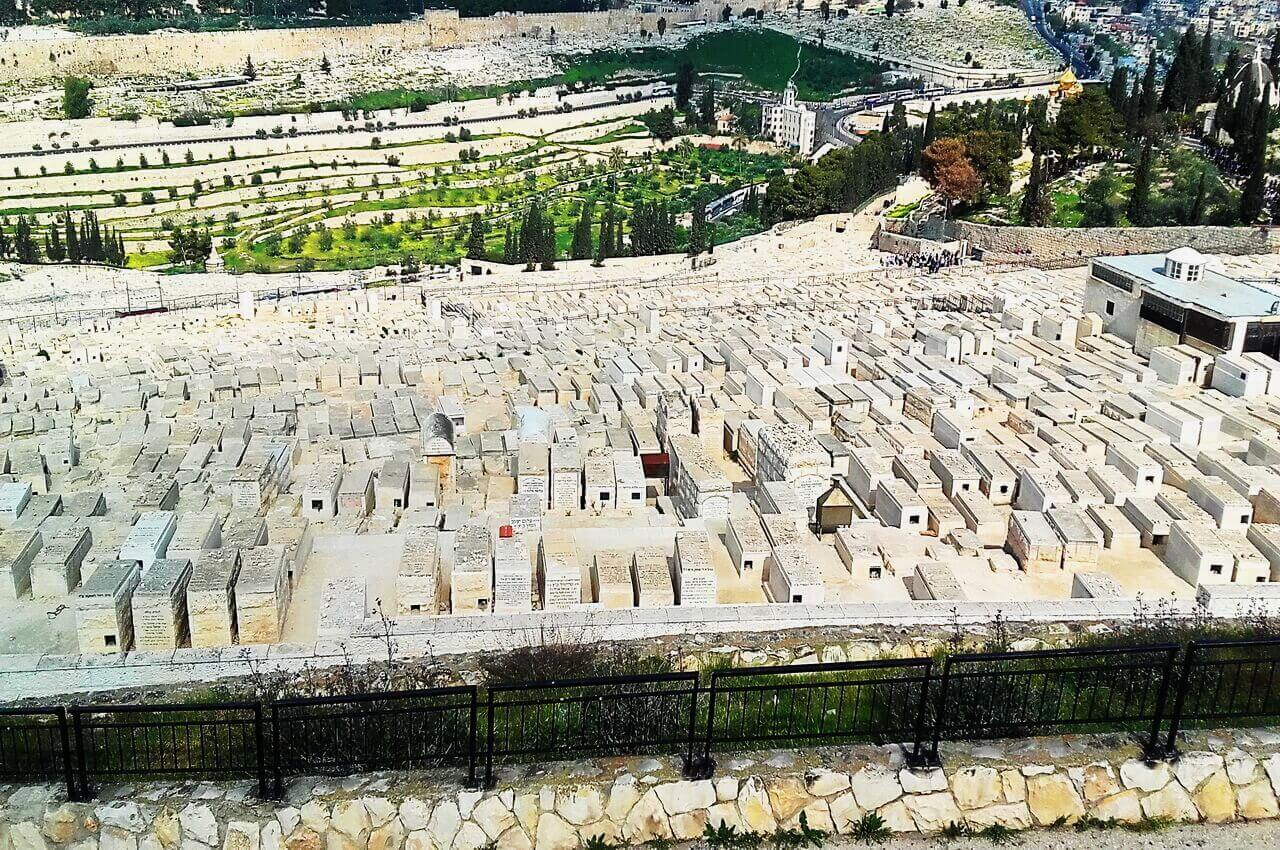
The Jewish Cemetery on the Mount of Olives
This place has served as a cemetery for more than 3,000 years. It is considered to be the location where the Messiah will return on the Day of Judgement. So, all those buried there will be resurrected, the righteous will receive eternal life, and sinners the final death. Well, today, this cemetery is a very expensive burial place.
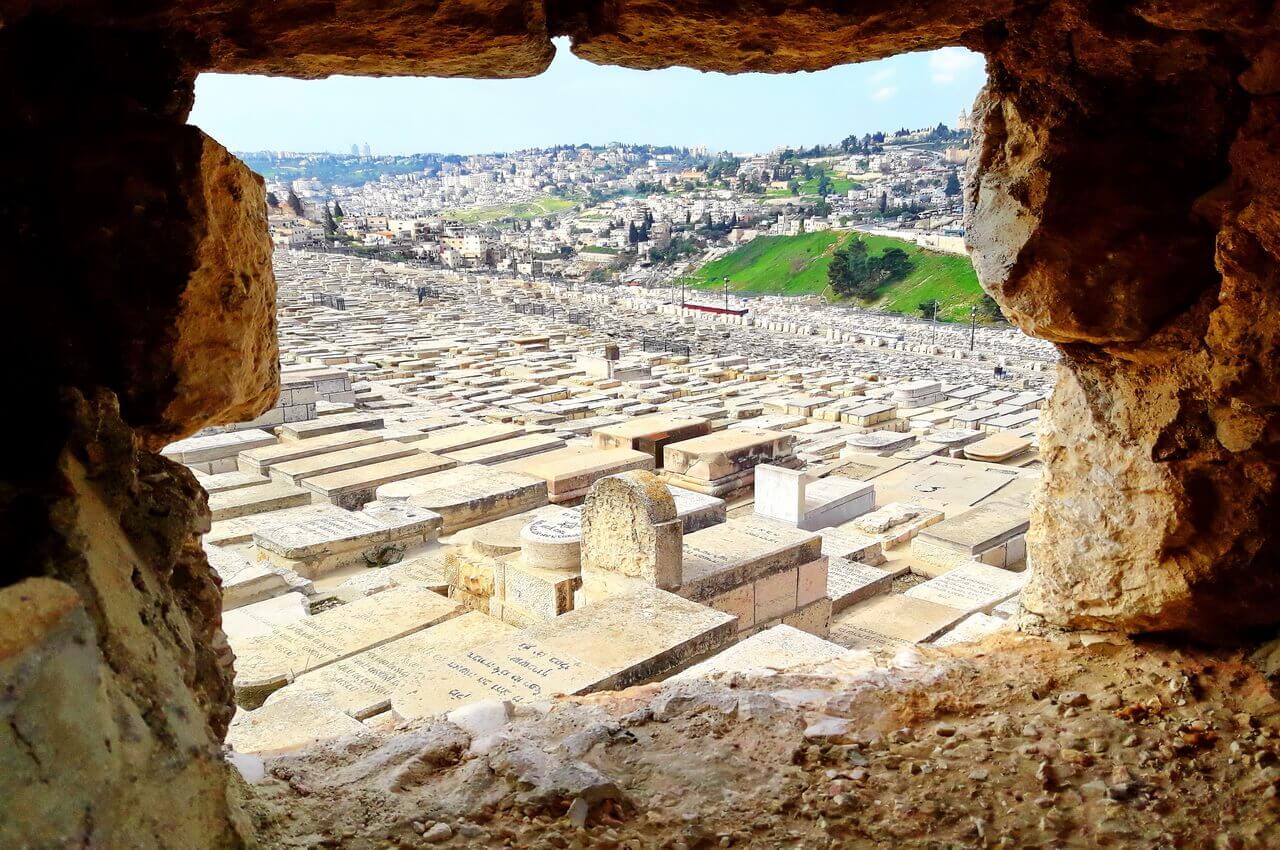
The Jewish Cemetery on the Mount of Olives
There are also several churches, mosques, and many tombs from the ancient period on the Mount of Olives.
And from the Mount of Olives, there is a fantastic view of Jerusalem.
This scene became a landmark of Jerusalem city.
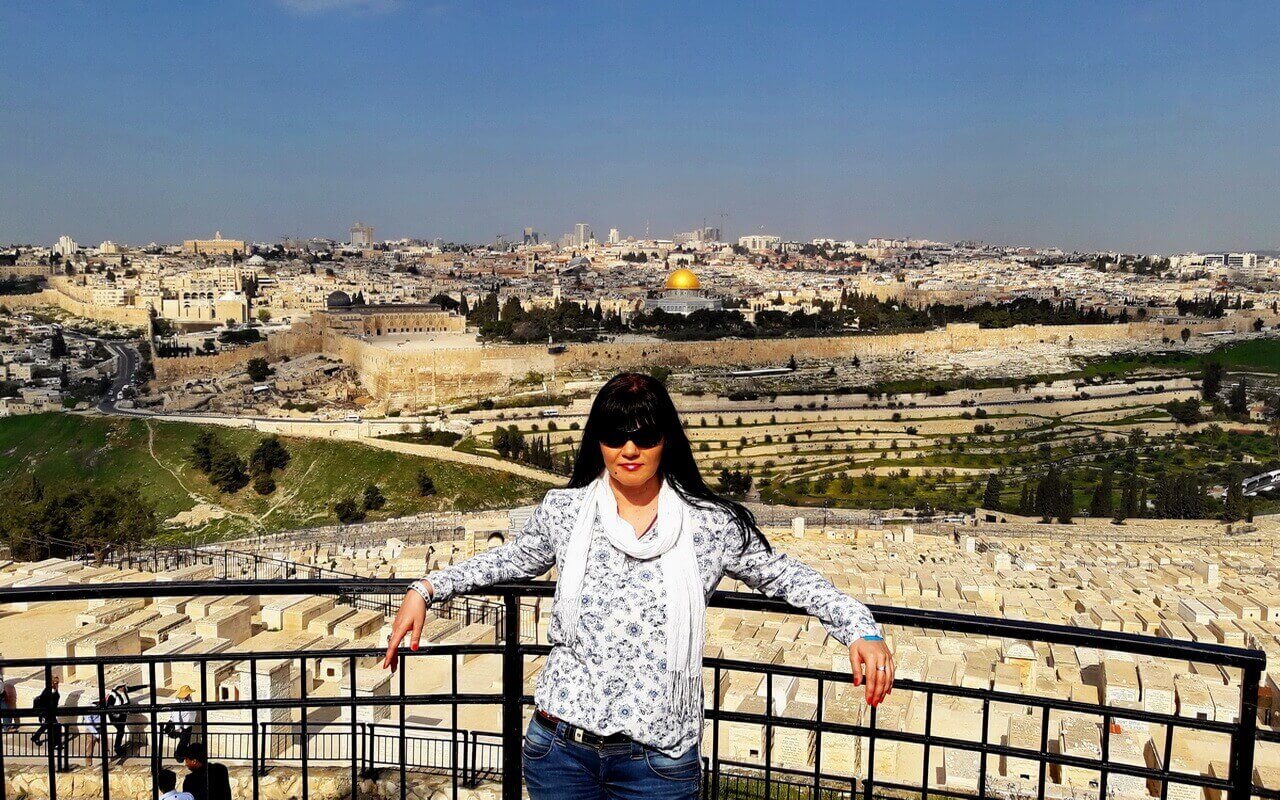
Panoramic view of Jerusalem
The Kidron Valley
We were going down through the Kidron Valley. It separates the Mount of Olives and the Temple Mount.
There you can see the Russian Orthodox church – the Church of Maria Magdalene, with a shining gold roof. It was built in 1886 by Tsar Alexander III and his brothers.
Also, in the valley is the Church of the Sepulchre of Saint Mary. It is believed that it is the burial place of Mary, the mother of Jesus. There are 47 steps leading from the entrance down into the crypt with the tomb. The walls are black because of the candle’s smoke and the ceiling is covered with many lamps, candles, and chandeliers. And inside there is a stone bench on which the Virgin’s body was laid out, known as the Tomb of Mary.
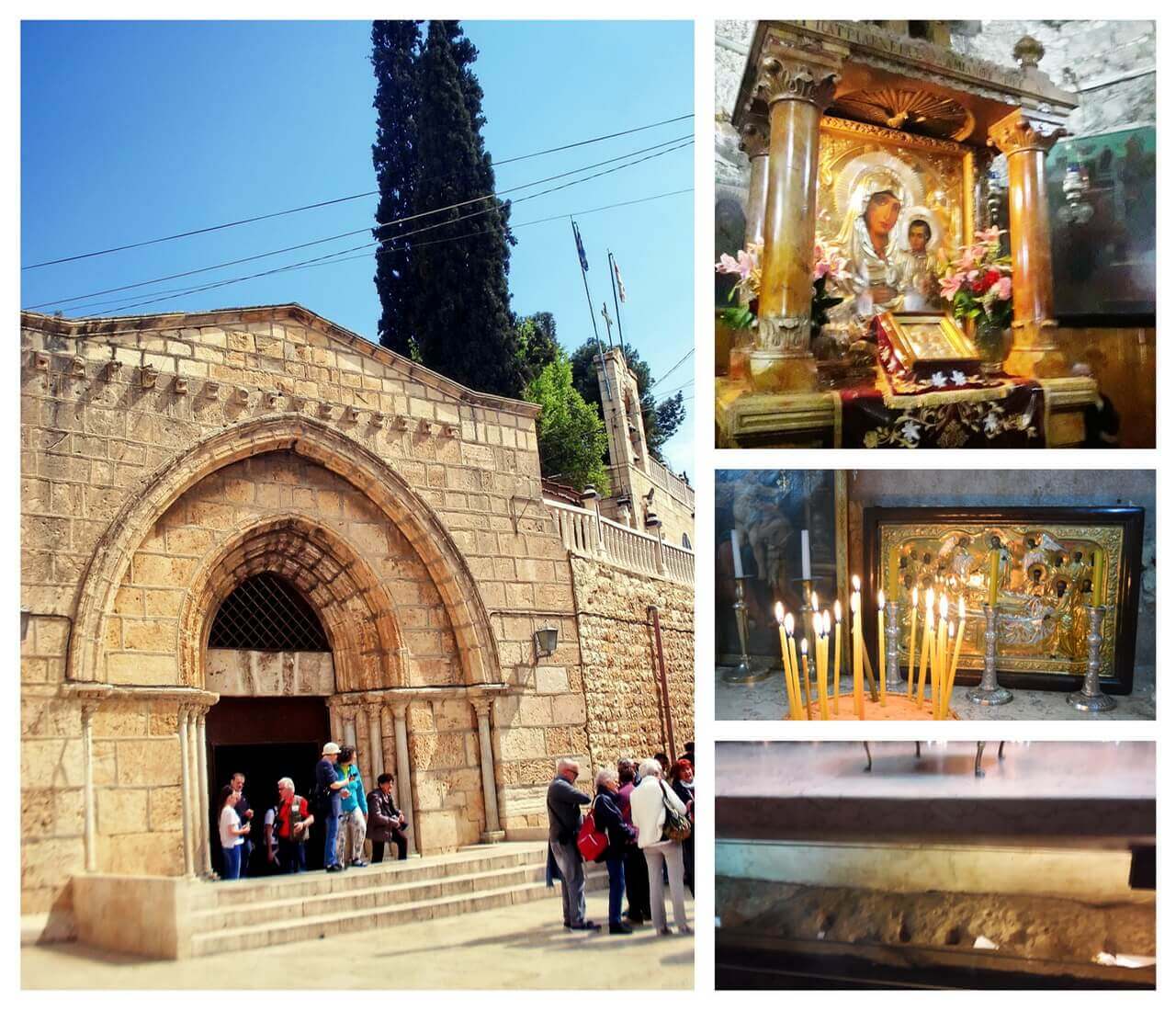
Church of the Sepulchre of Saint Mary
The Garden of Gethsemane and the Church of All Nations
At the footstep of the Mount of Olives, there is The Garden of Gethsemane and the Church of all nations.

The Russian Church on the hill, and the Church of All Nations
It is believed that some olive trees in the garden are about 2,000 years old. The Garden of Gethsemane is known as the place where Jesus and his disciples prayed after the Last Supper. He was betrayed by Judas and arrested by the Romans, and you know the rest of the story…
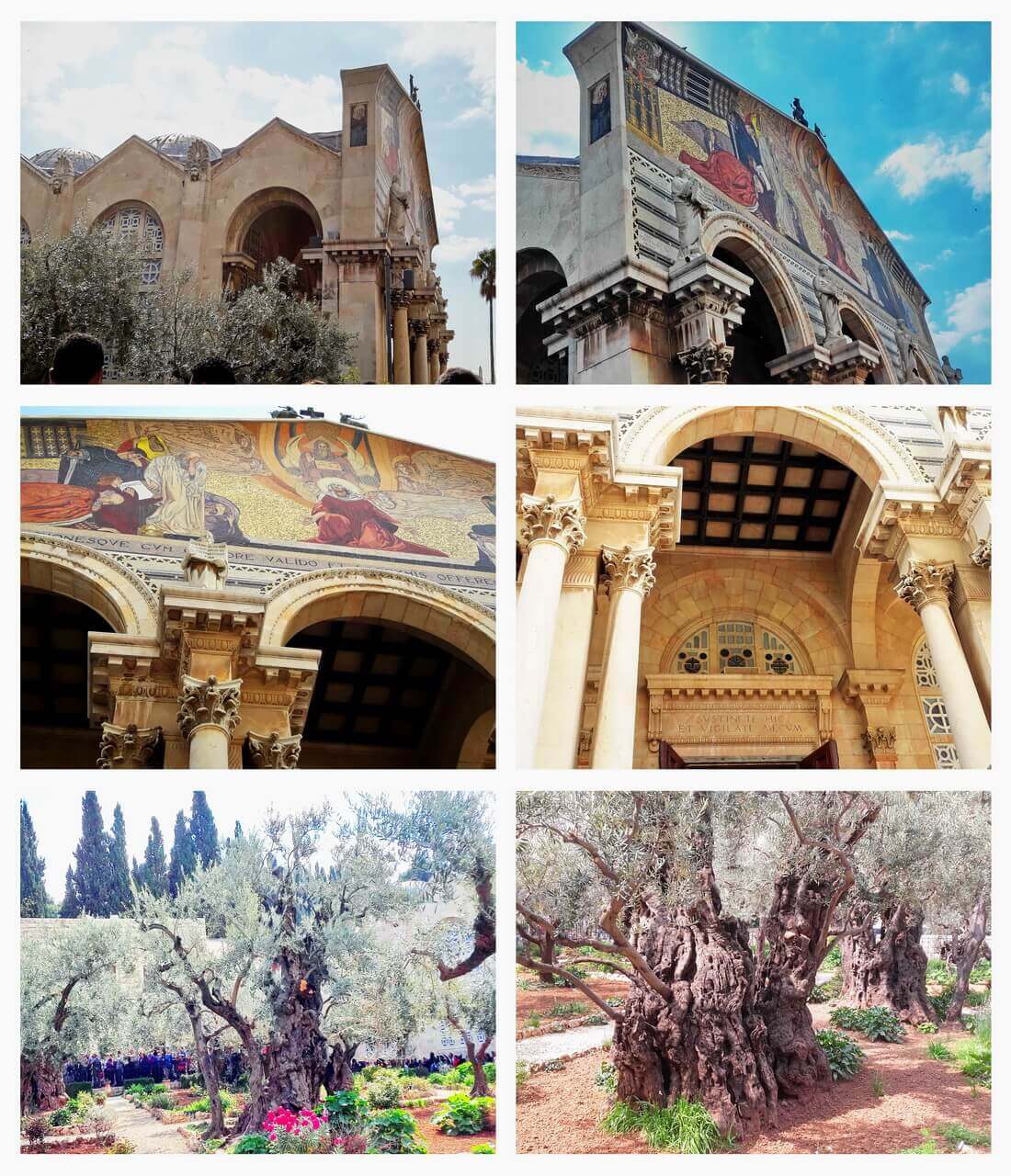
Jerusalem, the Garden of Gethsemane, and the Church of All Nation
The Church of All Nations is located on the edge of the garden. It is also known as the Basilica of the Agony because it was built around the rock where Jesus prayed. The church was built in 1924 on the remains of an earlier Byzantine church from the 4th century. It is a modern church with mixed styles, designed by Italian architect Antonio Barluzzi.
By the way, the Christian communities from 12 nations all around the world financed its construction.
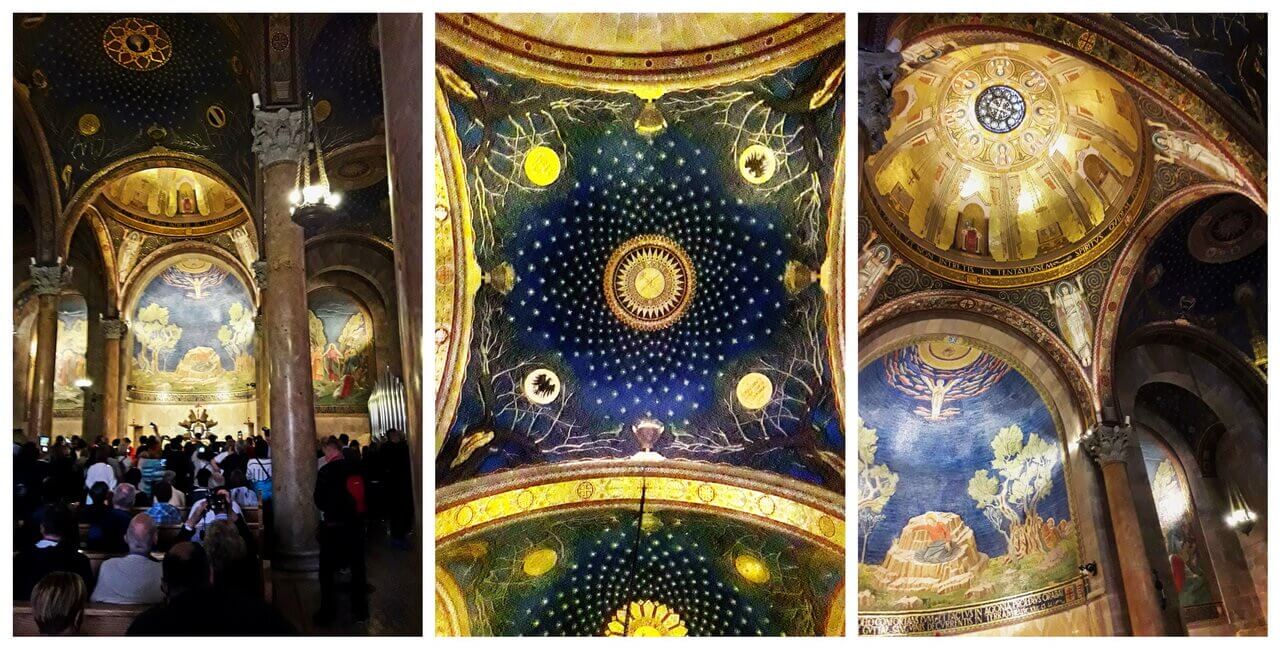
The interior of the Church of All Nations
There were a lot of pilgrims around the garden and the church.
But the small group of Ethiopic people attracted our attention.
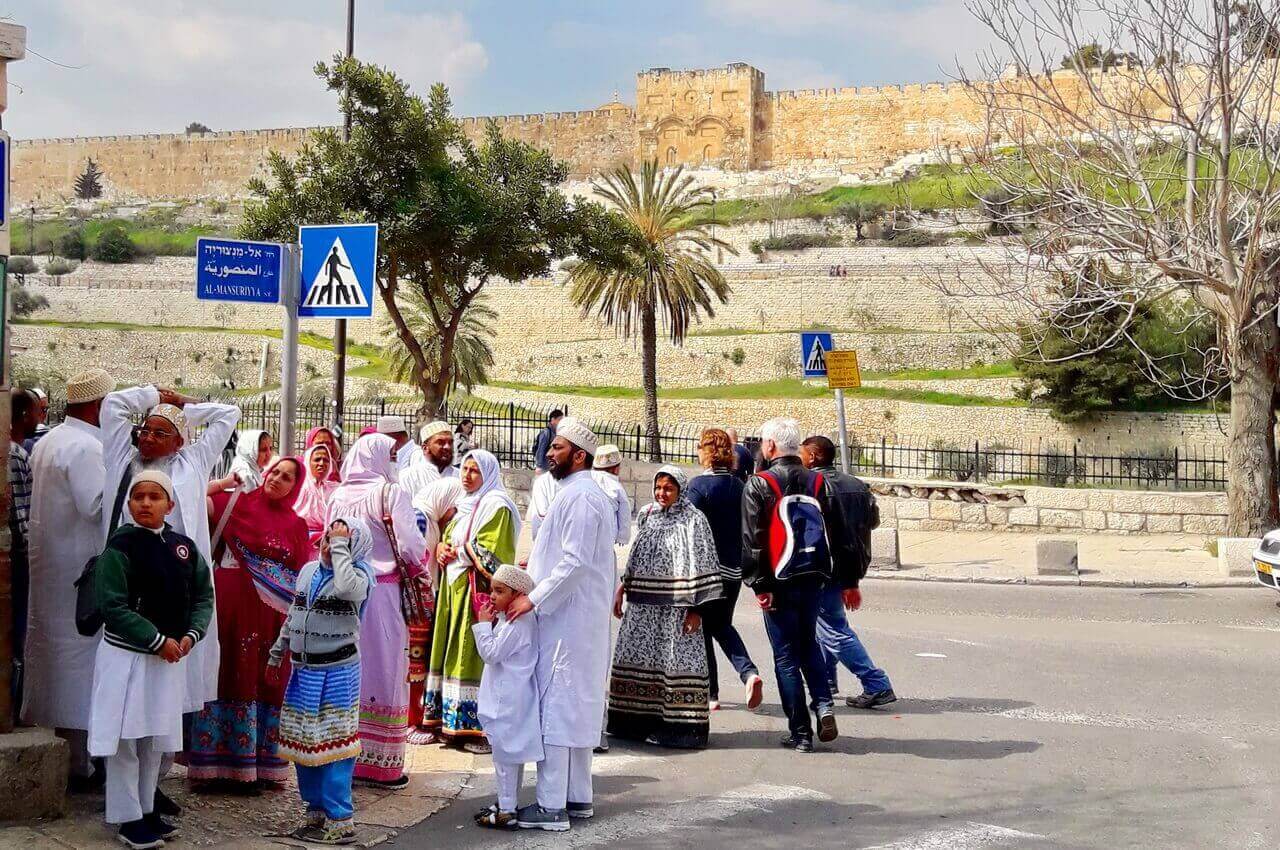
Ethiopian pilgrims, Jerusalem
The Old City of Jerusalem
It is supposed that the old city of Jerusalem was more than 3,000 years ago. Even today, it is a real labyrinth of narrow streets, high walls, small shops, churches, and various temples. According to Jerusalem’s law, all houses and buildings have to be built from stones.
The Old City covered an area of fewer than 1 km2. Once it was the whole of Jerusalem until 1860 when the Jewish neighbourhood was established.
Actually, the Old City is a holy and religious place. There are the Temple Mount and Western Wall for Jews, the Church of the Holy Sepulchre for Christians, and the Dome of the Rock and Al-Aqsa Mosque for Muslims. Also, the Old City was inscribed on the UNESCO World Heritage Site List in 1981.
Today, this small area is divided into 4 unequal and intertwined parts and quarters: Jewish, Christian, Armenian, and Muslim.
The gates and walls of Jerusalem
During different historic periods, there were various gates and defensive walls around the city.
For example, during the Crusades, there were four gates in Jerusalem. The Ottoman sultan Suleiman the Magnificent built the existing eight gates and the walls around the Old City from 1535 to 1542.
One of the most interesting gates is the Golden Gate.
It is known as the gate where Jesus, riding on a donkey, entered the city. The gate was opened and walled up a few times. But Sultan Suleiman walled it up in 1541 and has been sealed until today. One of the main reasons is that according to the Jewish tradition, the Messiah will enter Jerusalem through this gate.
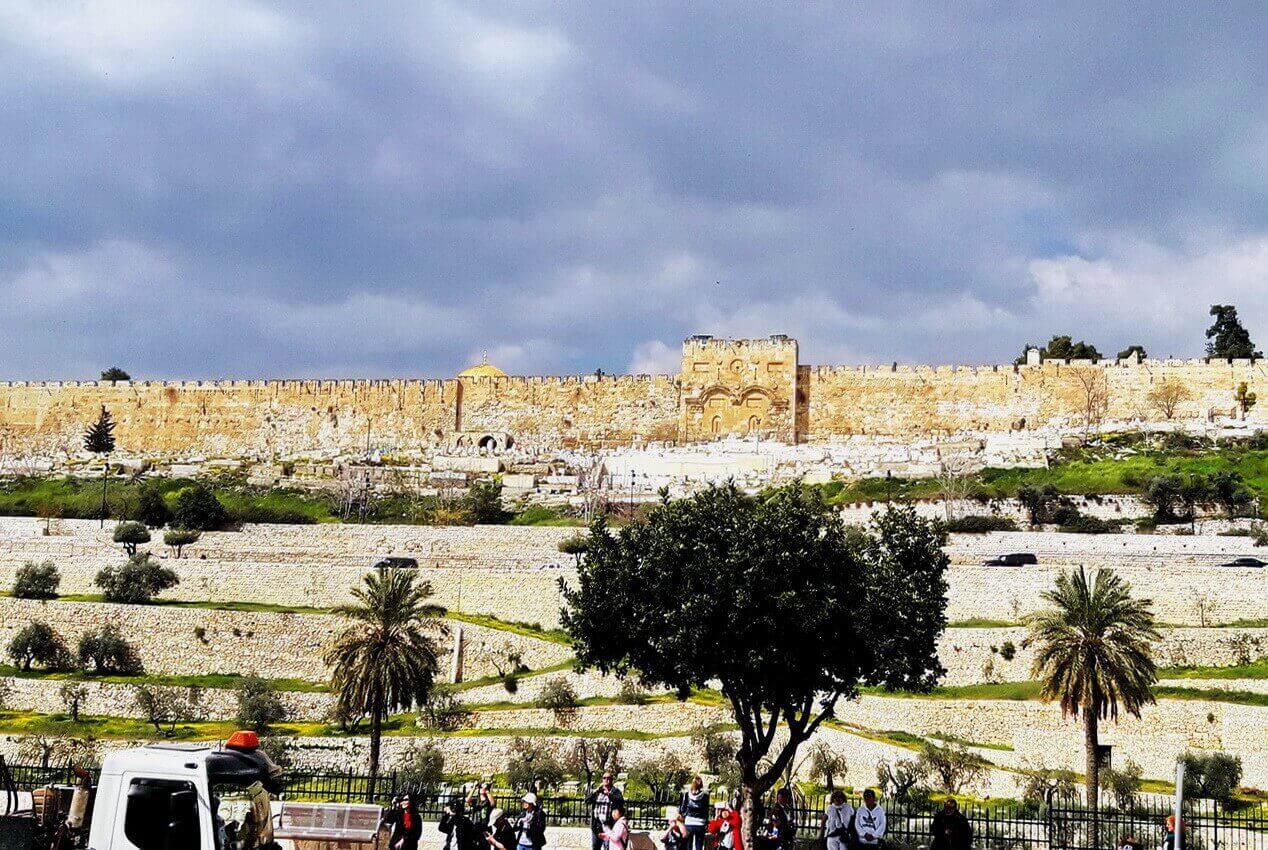
Golden Gate, Jerusalem
The Mount Zion
It is a hill located just outside the walls of the Old City.
The first time it is mentioned as the City of King David, according to the Hebrew Bible.
Also, it is used for the entire Land of Israel.
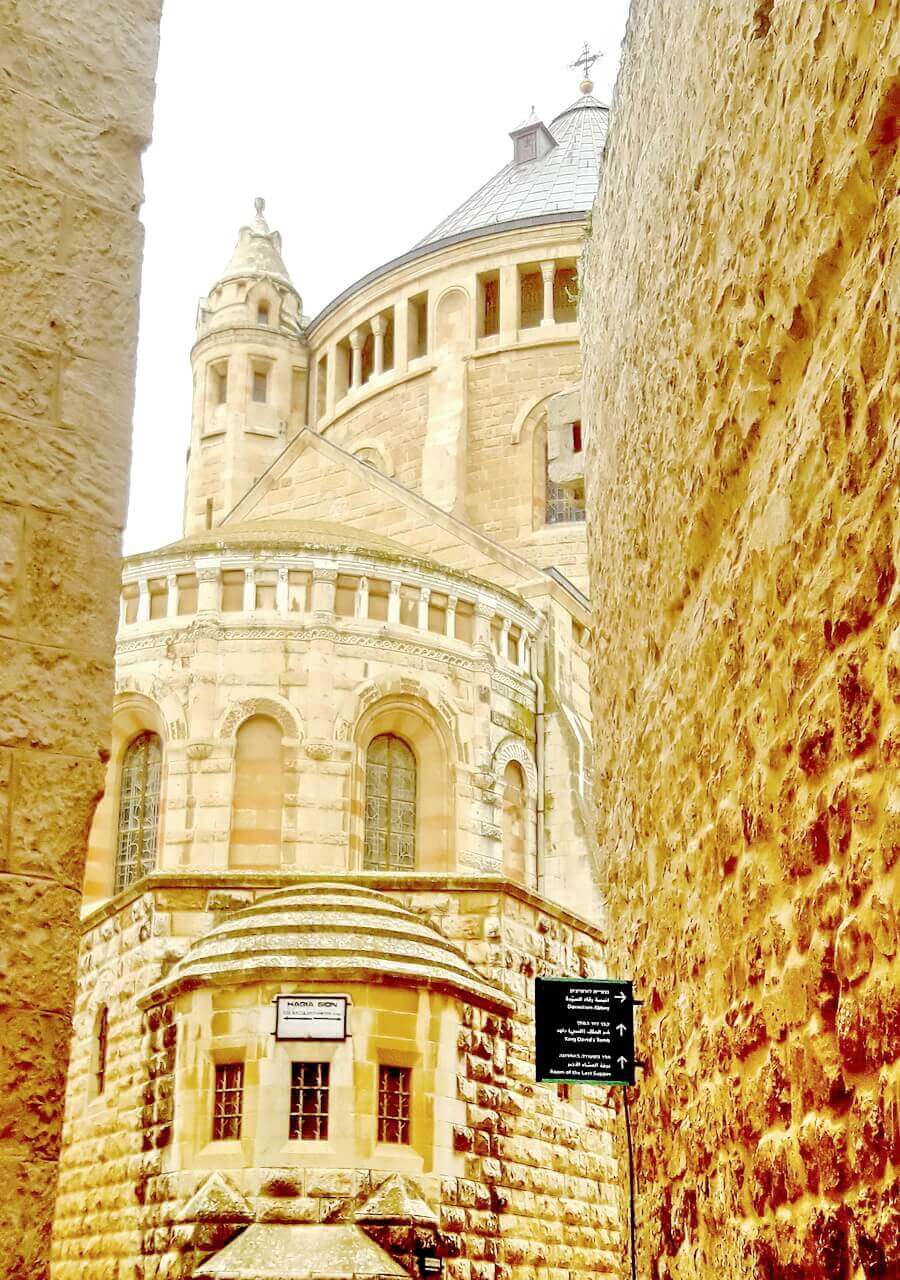
Dormition Abbey, Mount Zion, Jerusalem
So, there you can see the fantastic Dormition Abbey building.
It is an abbey and the name of a Benedictine community. It was established in the early 5th century, as the Byzantine basilica Hagia Sion. However, today’s modern building was finished in 1910, and it is known as the Basilica of the Assumption (or Dormition). Well, it is believed that at this place Mary, Christ’s mother spent her last moments. In the crypt, there is a statue of a sleeping Mary as well.
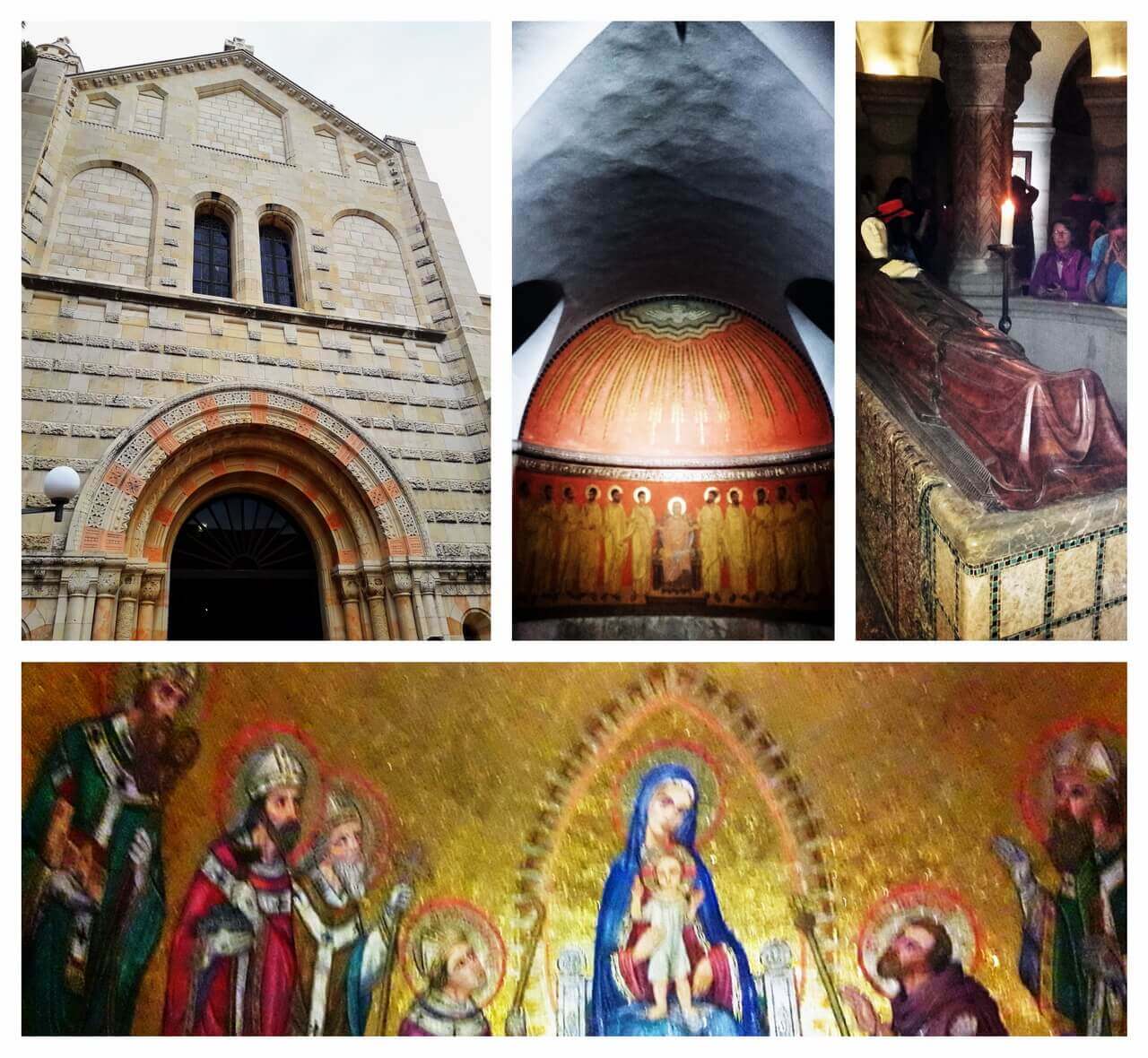
Basilica of the Assumption, Mount Zion, Jerusalem
King David
Close to the Dormition Abbey, you can see the statue of King David.
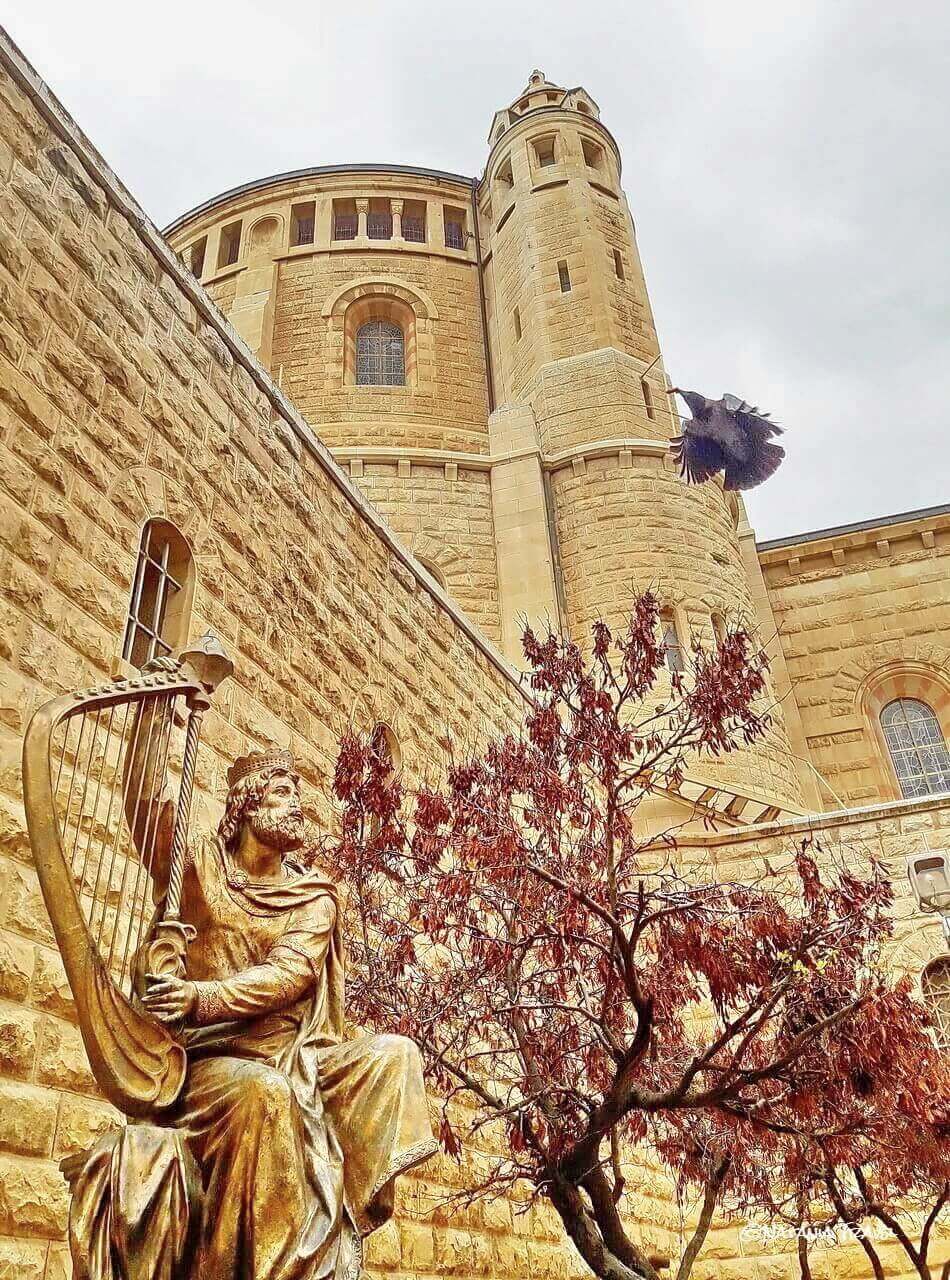
Jerusalem, Mount Zion, the statue of King David
On Mount Zion once was King David’s citadel city, about 3.000 ago. After him, the city was destroyed, rebuilt, and conquered many times, and it was hidden until 1860. The archaeological excavations are continued, and today you can see the remains and the museum through organized tours.
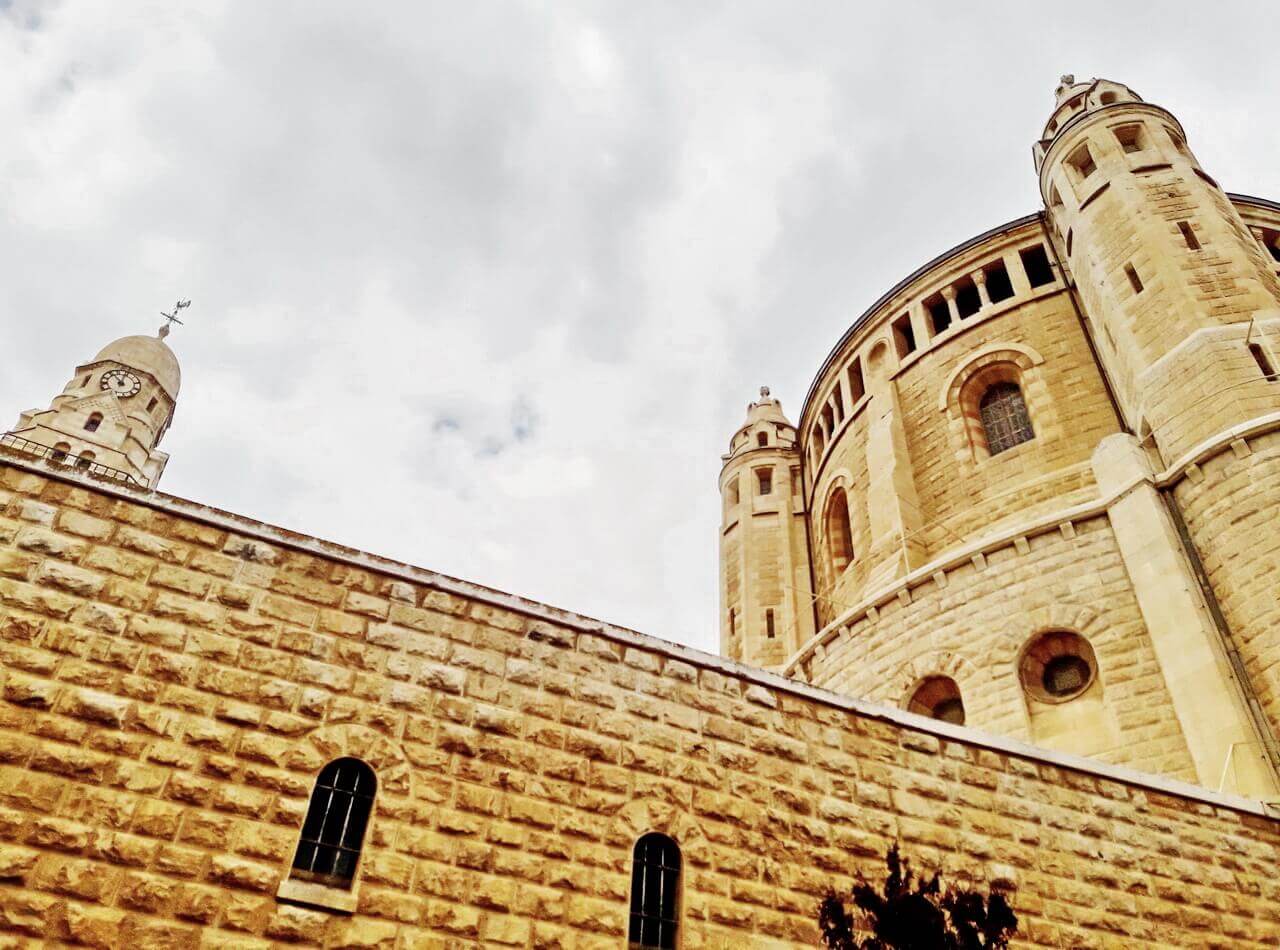
Dormition Abbey, Mount Zion
One of the most important sites is King David’s Tomb. Despite discussions about whether this is his authentic burial site, the pilgrims of all three religions visit this place. He was the King of the Israelites, he composed many of the psalms and he was the father of King Solomon.
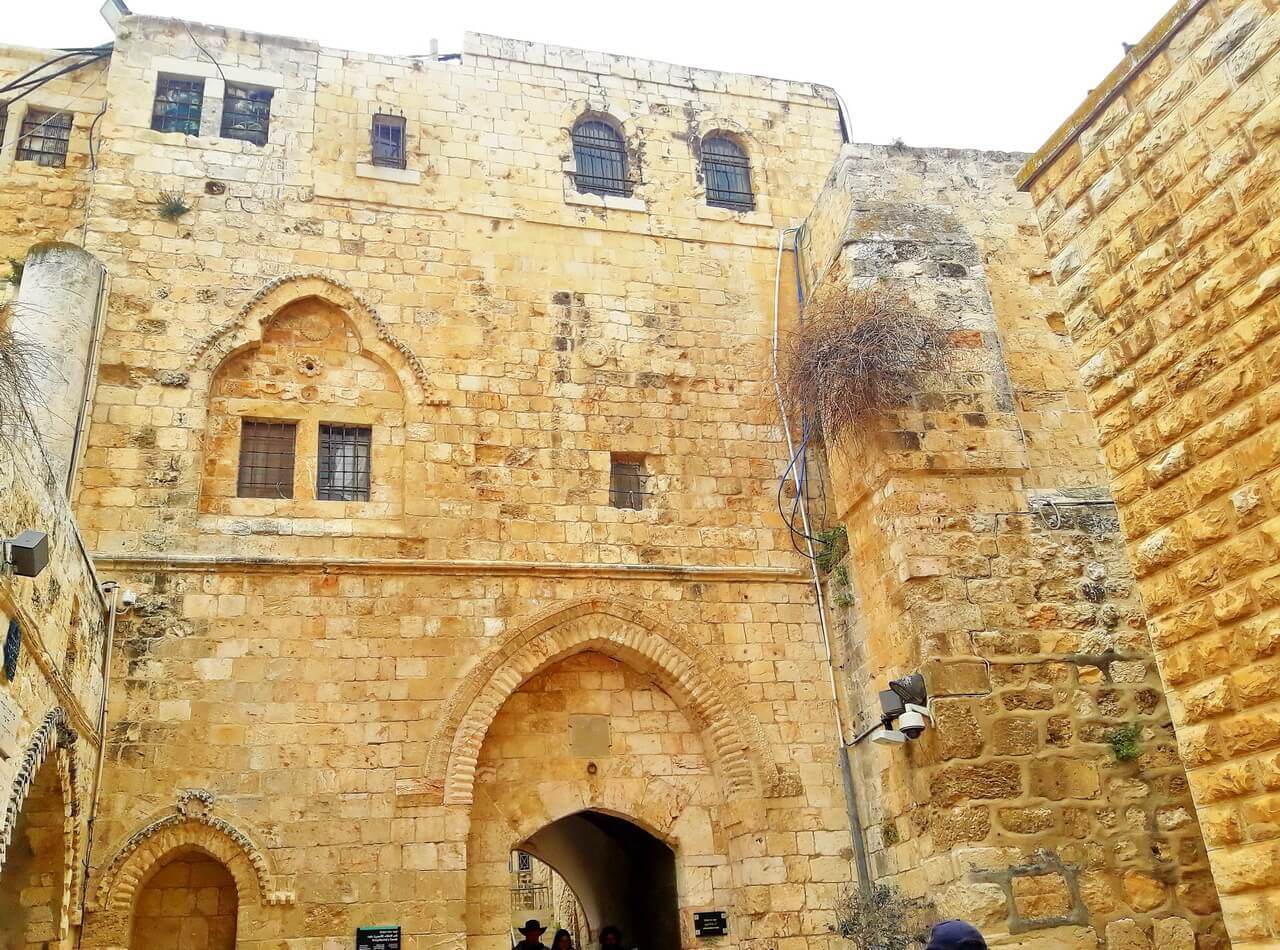
Room of Last Supper building, Mount of Zion
David’s sarcophagus is located in the ground-level room built by the Crusaders on the remains of an earlier synagogue church, used by Roman and Byzantine-era Jewish and Christians. In the 14th century, the Franciscans renovated the building, and the Muslims converted it into a mosque in the 16th century. Taking photos of the tomb is not allowed.
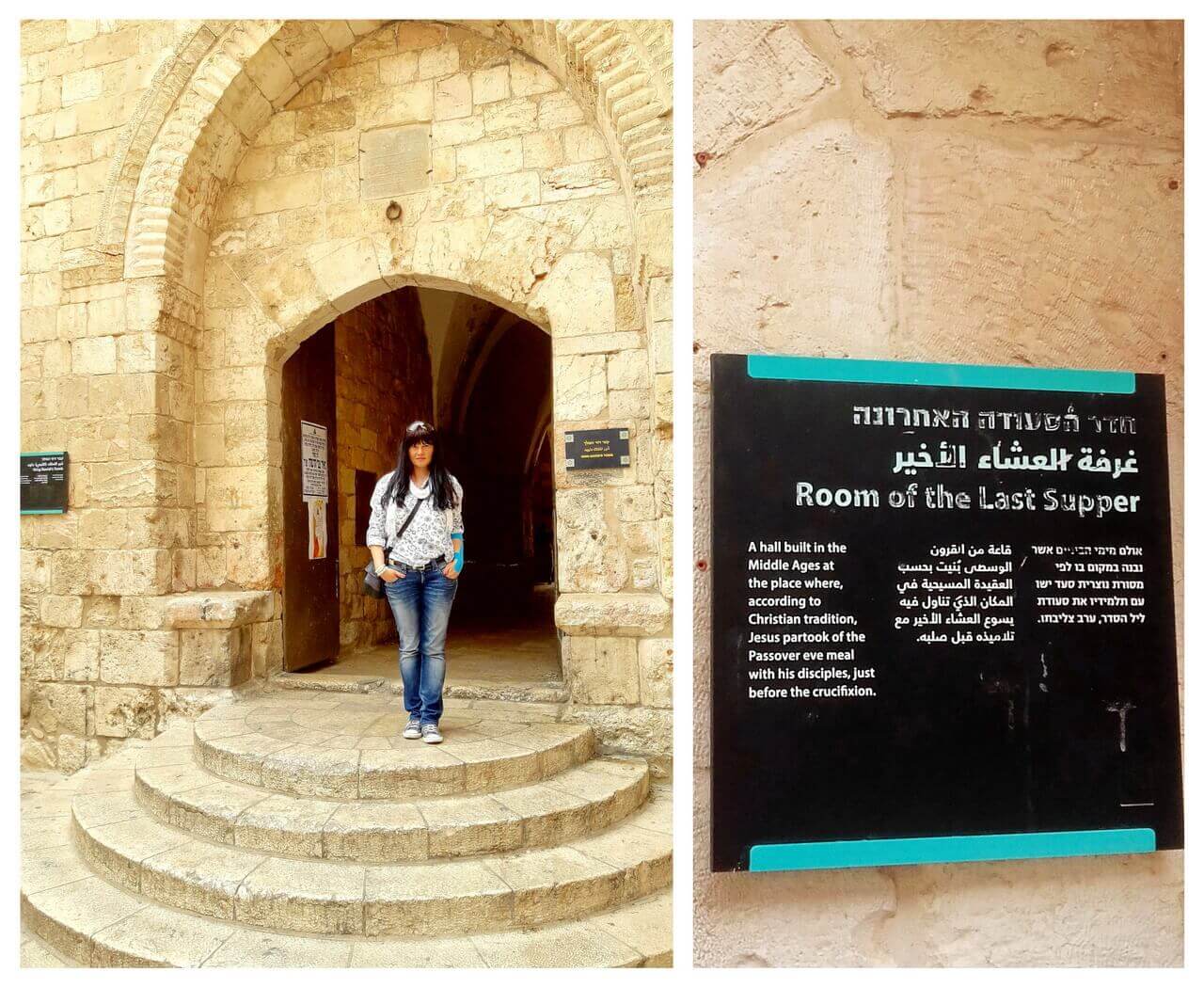
Entrance to the building with the Room of the Last Supper
Room of the Last Supper
On the second floor of this building is the Room of the Last Supper, where Jesus was held the Secret Last Supper was held, as well. It is also known as the “Cenacle” or “Upper Room”. This building was destroyed and restored many times. The Ottomans converted to a mosque during their rule which is marked on the wall description from 1452. Also, there are two stained glass windows with Arabic inscriptions, the statue of the golden olive tree, and a small canopic dome with marble columns over the stairs.
In a word, this room is a fantastic mix of different segments of Jewish, Christian, and Muslim history.
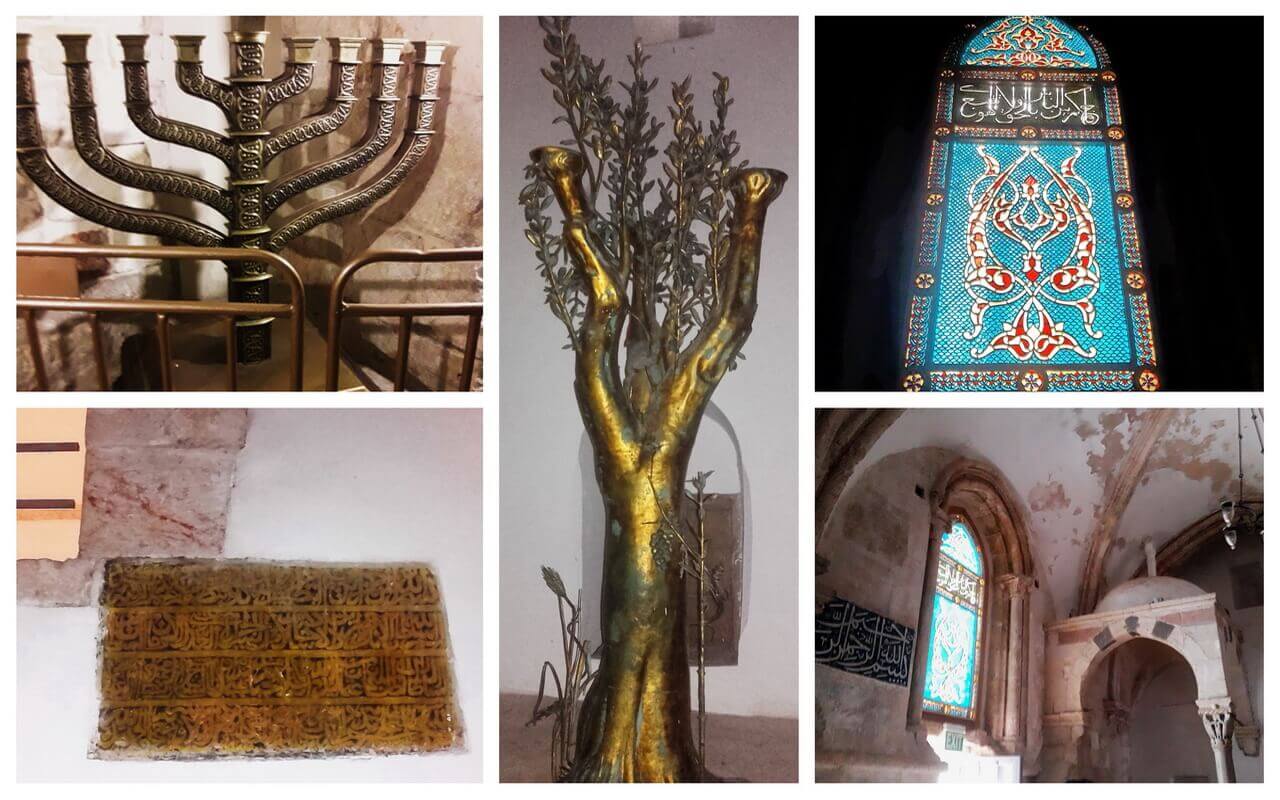
Room of the Last Supper
Zion Gate
The walls that belong to this gate were built in 1540 under the rule of Suleiman the Magnificent. This is one of seven gate entrances in the Old City (the eighth gate is the sealed Golden Gate). Through the Zion gate, you enter the Old City and the Armenian and Jewish Quarter. It is also called the Jewish Gate and the Wounded Gate because you can see the bullet holes from the 1948 Israeli War of Independence.
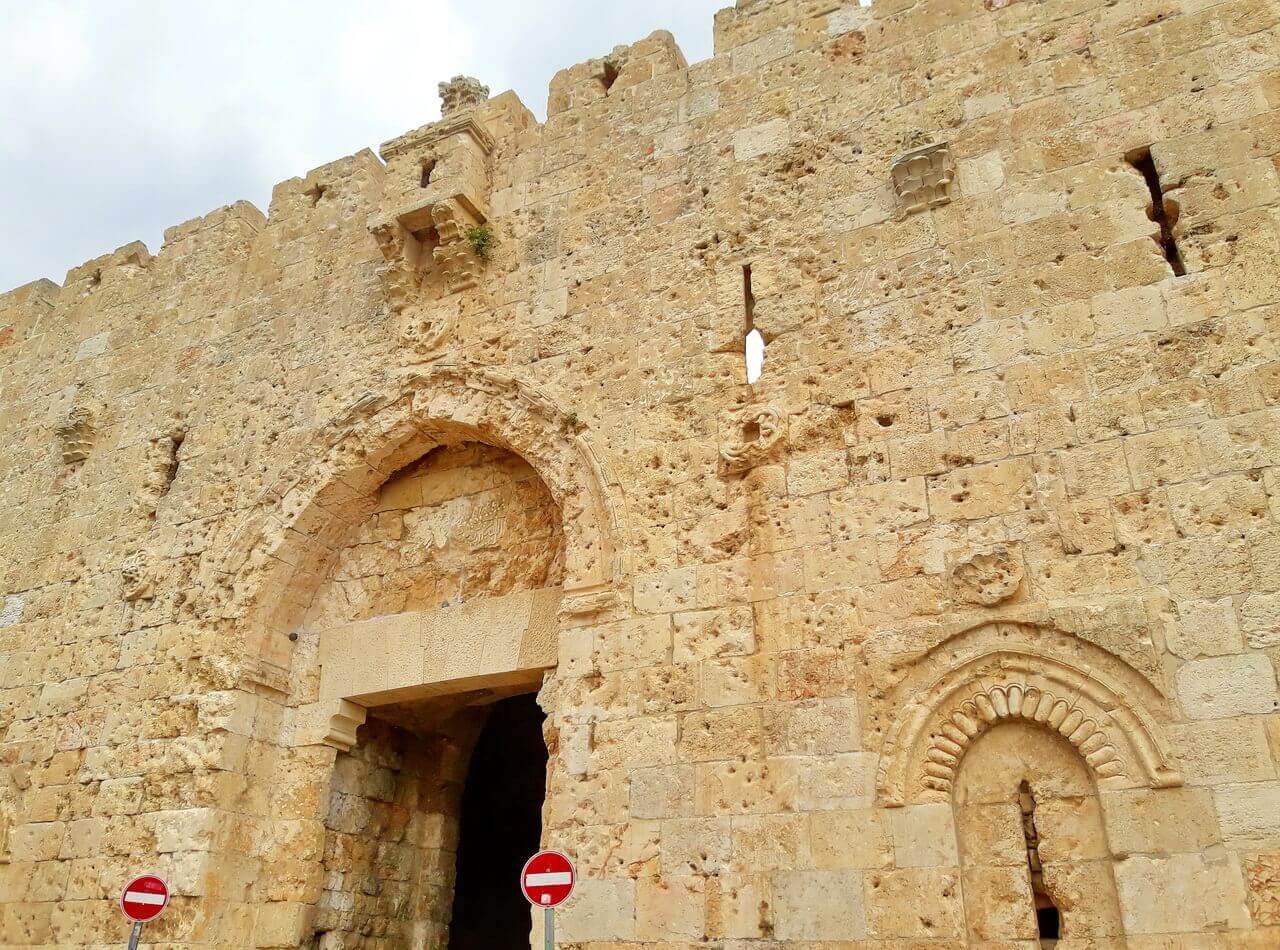
Zion gate
Armenian Quarter
The Armenian Quarter is the smallest of all four quarters. Actually, it covers about 14% of the total area of the Old City, and it is located in the southwest corner. Today in this quarter you can see the Armenian Patriarch of Jerusalem, an Armenian museum, a library, and the Cathedral of St. James, built in the 12th by the Crusaders.
Jewish Quarter
It is located in the southeastern part of the Old City, city, from the Zion Gate in the south, along the Armenian Quarter, and extends to the Western Wall and the Temple Mount in the east.
There you can see restaurants, shops, hotels, hostels, museums, and many Jewish religious schools and synagogues.
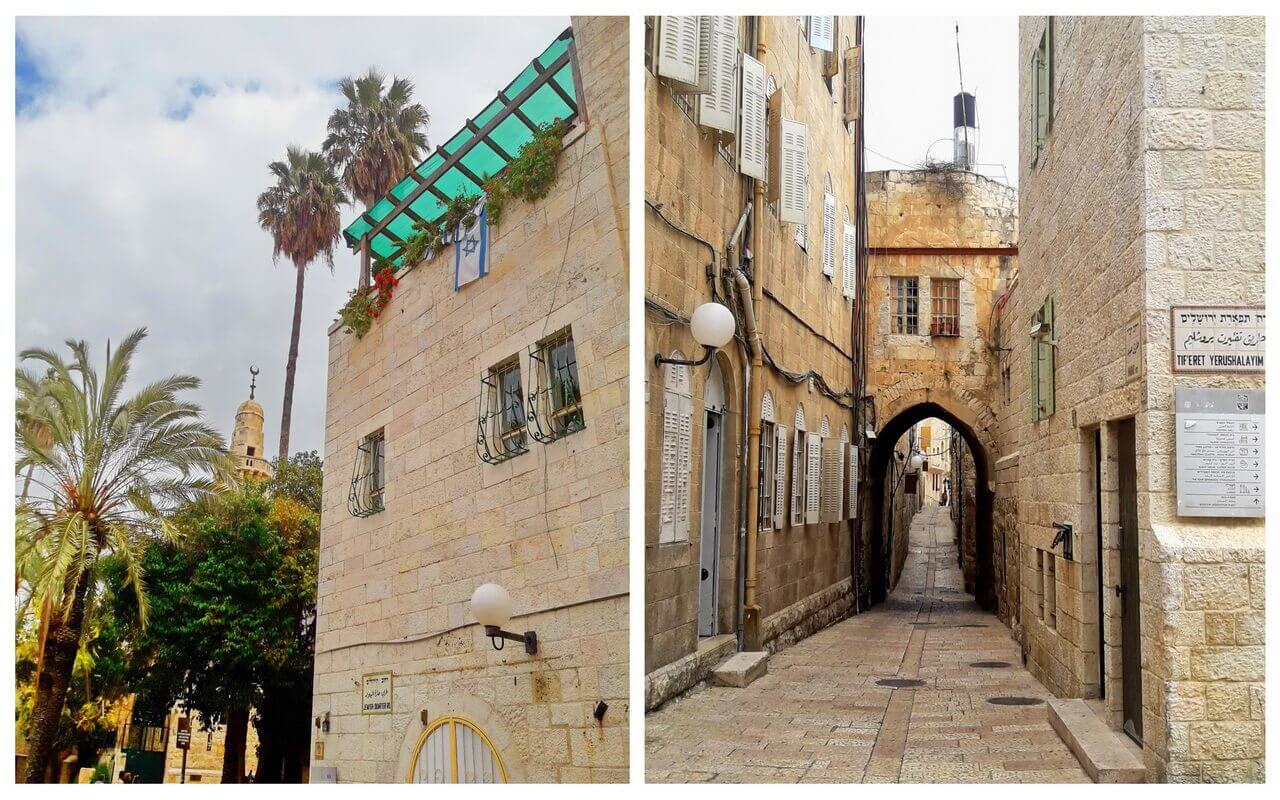
Jewish Quarter
One of the most interesting streets in the Jewish quarter is Cardo Maximus. The remains were found during the excavations in 1969. The Roman Emperor Hadrian rebuilt Jerusalem in the 130s AD, like other Roman cities. By the way, the “Cardo” means “heart” in Latin, meaning that the Cardo was the main street and ran through the heart of the Roman cities.
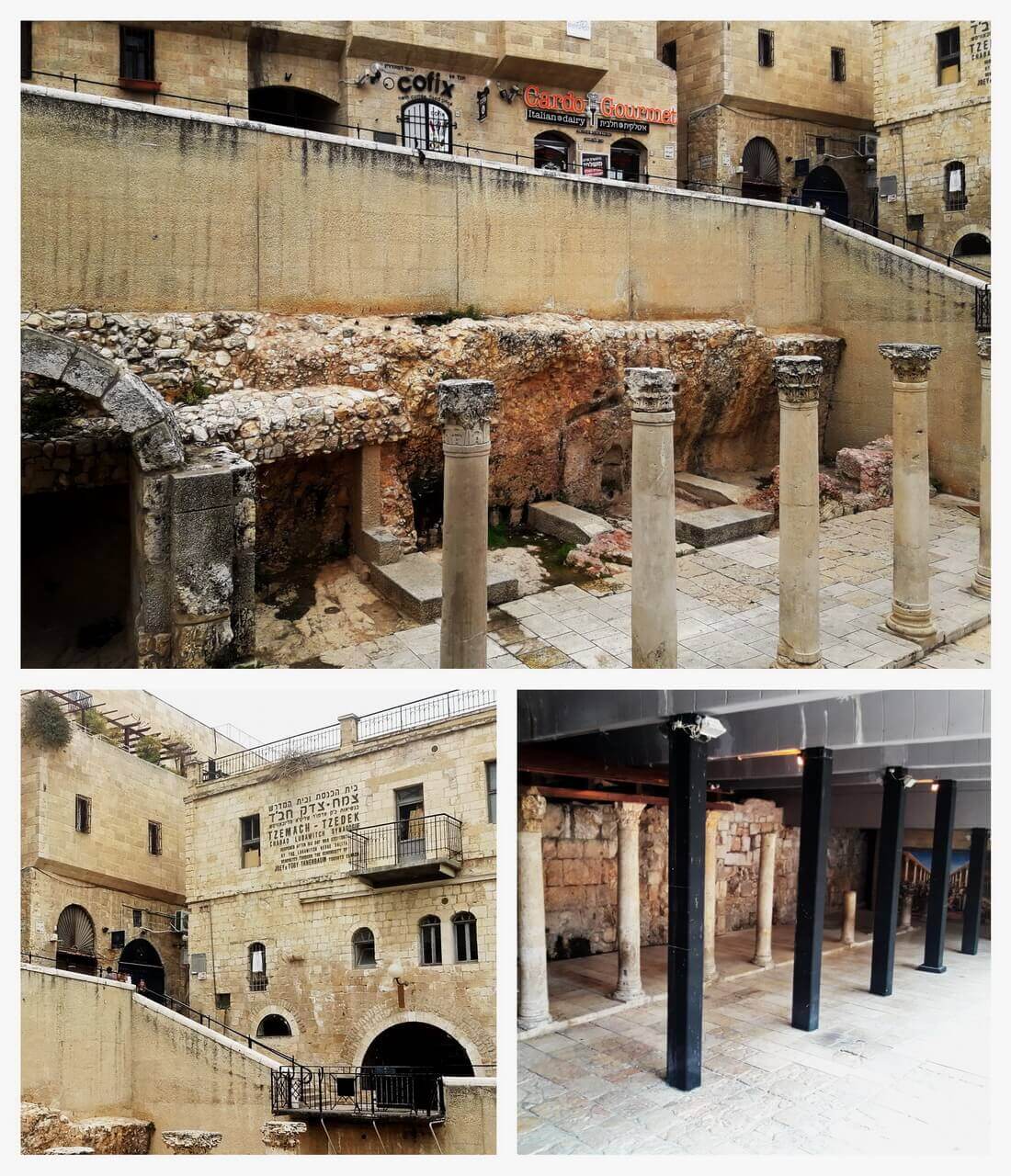
Cardo Maximus in Old Town
Cardo was paved and about 22 meters wide road filled with colonnades, arcades, and covered walkways. In the 7th century during the Muslim rule, it became a marketplace, and later, the Crusaders used it as a bazaar in the 12th century as well. Today we can see only a few columns and the pavement.

The old City of Jerusalem
The Temple Mount (Haram Al-Sharif) in Jerusalem
The Temple Mount is a very sacred and important place for Jews, Christians, and Muslims. So it is known as Haram Al-Sharif, the Noble Sanctuary, and Mount Moriah as well. Today it is a plaza on an elevated area, nestled behind the Western Wall in the south-eastern corner of the Old City.
Jews believe that it was a place where once stood the original Ark of the Covenant, a gold chest with two stone tablets bearing the Ten Commandments brought down from Mount Sinai by Moses.
King Solomon built the First Holy Temple in 957 BC, which was destroyed by Babylonian King Nebuchadnezzar in 586 BC. Also, the Second Holy Temple was built in the same place in 516 BC during the role of Judean ruler Herod. The temple was the main place where Jewish sacrificial rites were performed and the main seat of the Jewish faith. It was destroyed completely in 70 AD by the Romans during a Jewish uprising.
Temple ruins were hidden for centuries. Today new structures were built and covered the mount.
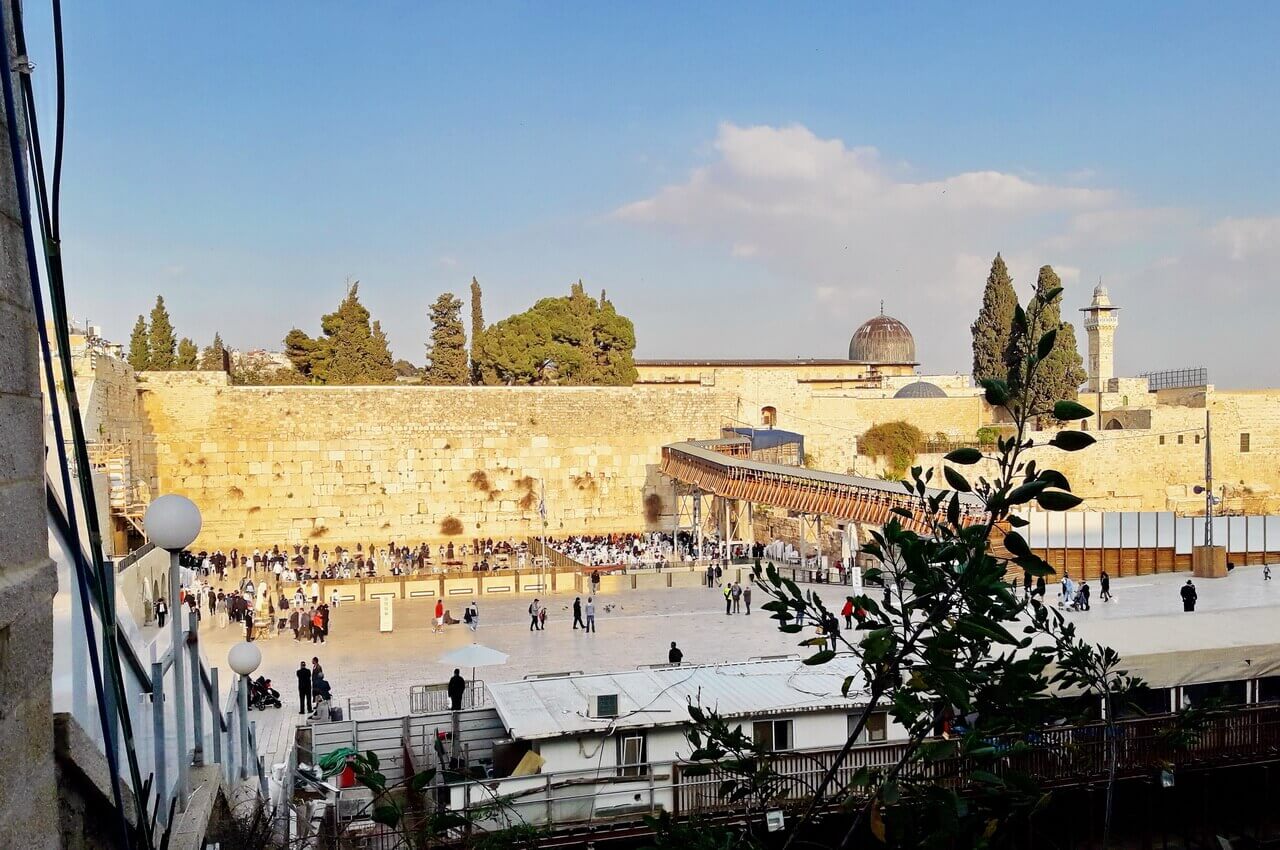
Western Wall, Jerusalem
Praying on the Western Wall
The main part of the Jewish Quarter is the Western Wall or Wailing Wall. Today it is a 485-meter-long part of the wall constructed under Herod the Great as part of expansions of the Jewish Second Temple (516BC – 70AD). And the original wall is encased under the Temple Mount.
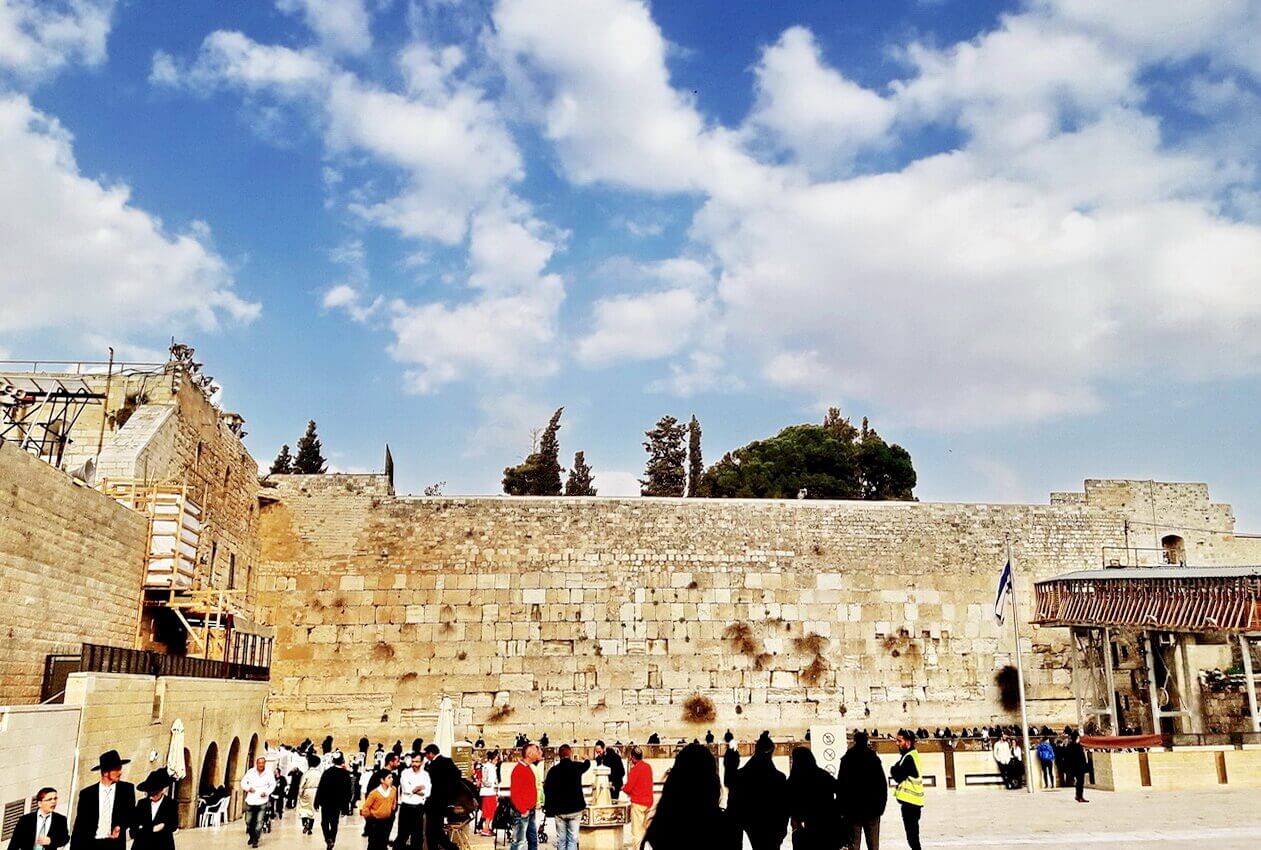
The Western Wall
For Jews, today’s remains of this wall are a connection with the Holy Temple Mount. According to them, the Temple Mount is the place where God’s divine presence is manifested more than in any other place in the world. So they pray on the wall day and night or recite the Book of Psalms. And it is called the Wailing Wall because the Jews weep and cry for the destroyed Temple. They are dreaming and praying about the date when the Holy Temple will be reconstructed again.
There are two separate sections for praying: one larger for men and one smaller for women. But non-Jews pilgrims and visitors are praying on the wall as well. It is a custom to write one or more of your prayers or hopes on a small piece of paper to God and put it in the tiny cracks in the wall. According to Jewish law, written prayers could not be thrown away or burnt. So, twice a year, these prayers are collected and buried in the Jewish cemetery on the Mount of Olives.
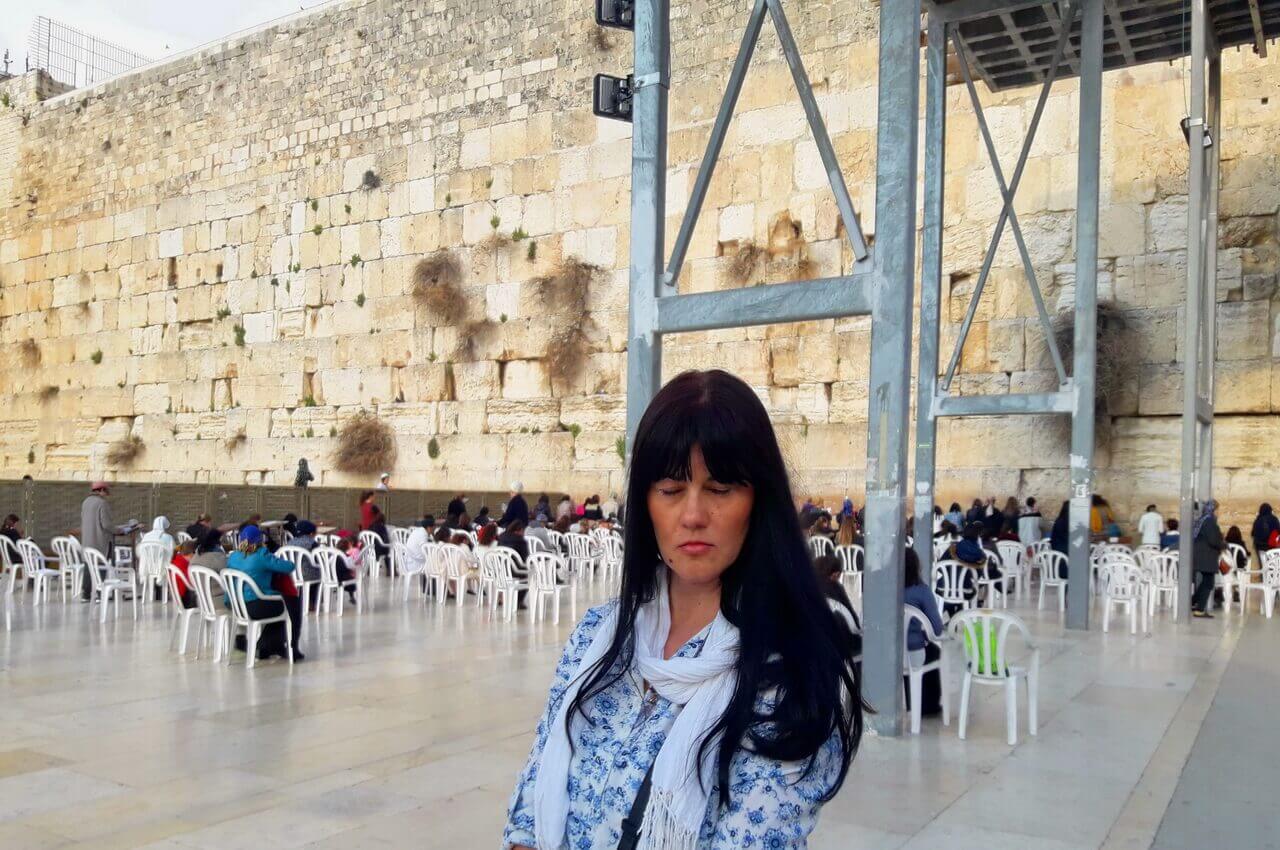
The Western Wall and part for women praying
Useful information:
Since it is a sacred place, men must cover their heads, and women have to cover their shoulders and legs.
The taking of photos is not allowed in the prayer area. But we could not resist taking some of them because praying on the Western wall is an unusual and extremely emotional experience.
Muslim Quarter
As I have already mentioned, the Temple Mount is a holy place for Muslims as well, after Mecca and Medina.
It lies in the northeastern corner of the Old City. Actually, the Western Wall is one of the borders between the Jewish and Muslim quarters. The Muslim Quarter is the largest of the four quarters and it is very similar to the Jewish Quarter. Both have narrow alleys, but there is more crowd in the Muslim quarter. The Old Market is located there with many little shops selling various products, food, spices, souvenirs, and clothes.
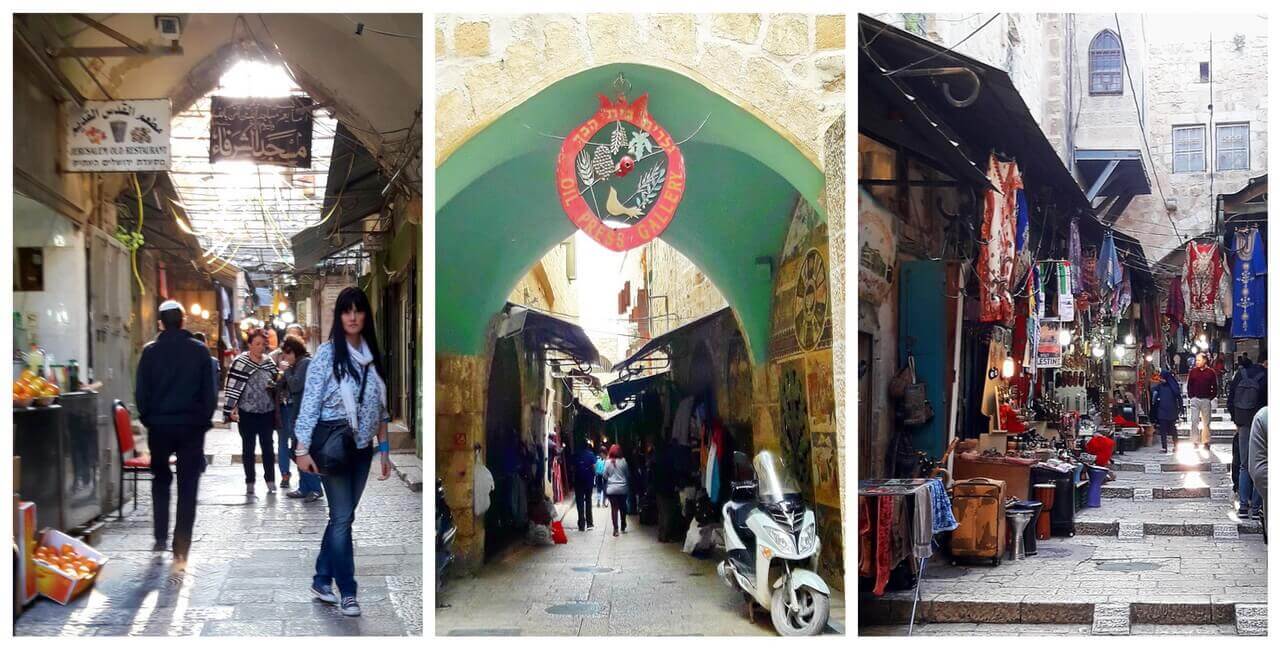
Old Market, Jerusalem
The two most important Islamic shrines are located in this area: the Dome of the Rock and the Al-Aqsa mosque.
The Dome of the Rock
When the Muslims conquered Jerusalem in 638AD, they built the Dome of the Rock at the place where were the ruins of the Jewish Second Temple. It was completed in 692 CE at the order of the Islamic Umayyad dynasty. In fact, it was built over the Foundation Stone and the Cave of Spirits, or Well of Spirits in Islam.
This place is the holiest site in Judaism. According to the Talmud, God gathered the earth and formed it into Adam, the first man. Also, on this stone, Abraham offered his son Isaac to sacrifice. And Muslims believe that the shrine holds the rock from which the Prophet Muhammad stepped up to heaven.
By the way, the Dome of the Rock is one of the oldest existing Islamic structures in the world.
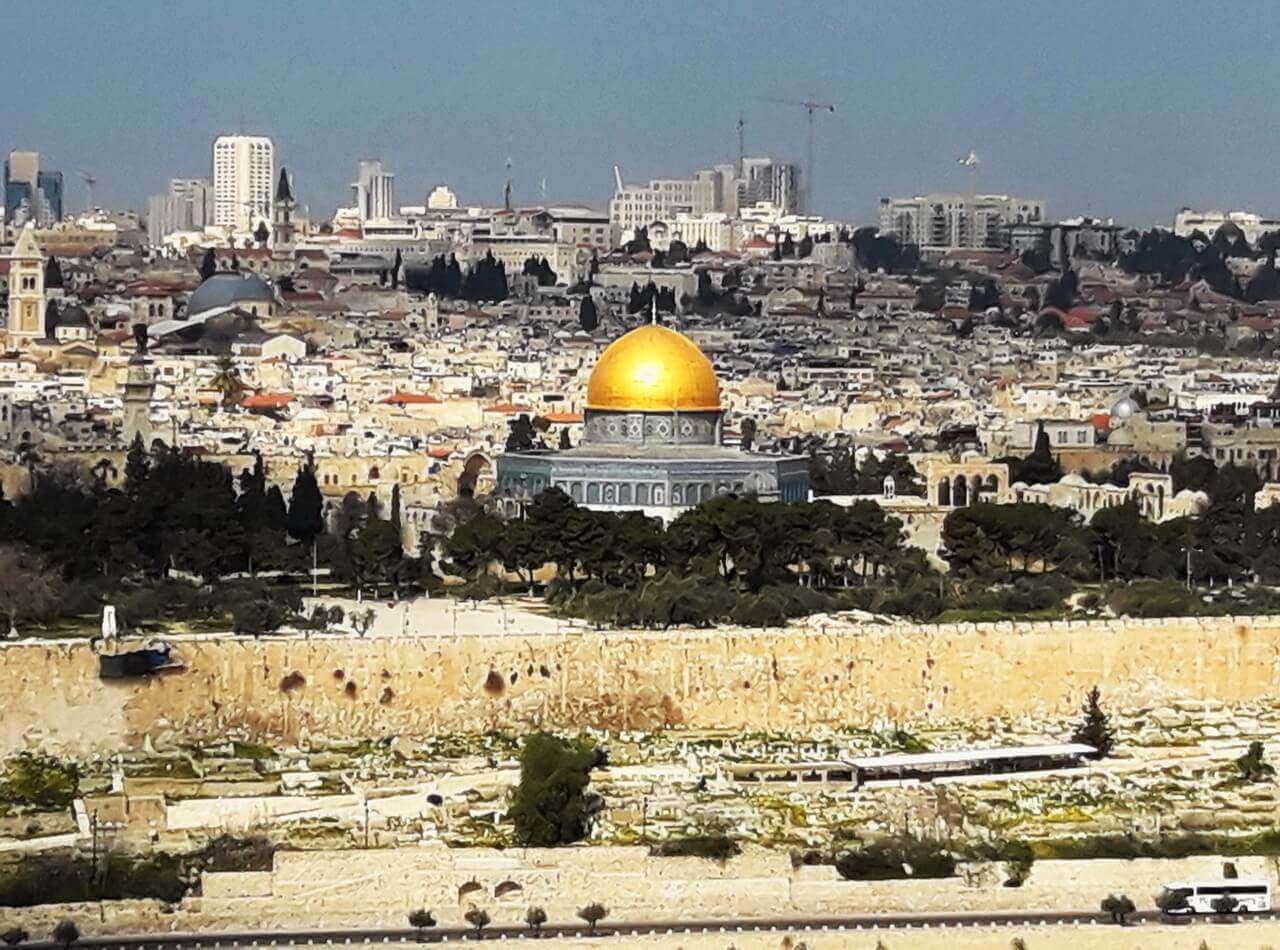
The view of The Dome of the Rock, Jerusalem
The original 7th-century structure collapsed in 1015, and the one we see today dates back to 1023. During their rule, the Crusaders transferred it into the church, but the sultan Saladin was reconstructed in a Muslim shrine in 1187. The dome has an octagonal structure. First, it was wooden and covered with tiles during the rule of the Suleiman Magnificent.
There were many restorations, but the final look makes the Dome the landmark of the Old City. Until the 1960s it was covered by plain lead. During Jordanian rule, the lead was replaced with shining aluminium-bronze plates covered with gold leaf. Even King Hussein of Jordan donated US$ 8.2 million to fund 80 kilograms of gold to recover the dome. Well, it is a real gold shining dome 🙂
The Al-Aqsa Mosque
The Al-Aqsa is known as “the silver-domed mosque”. The current construction of the mosque is dated to the early Umayyad period when the Dome of the Rock was built. Muslims believe that the prophet Muhammad was transported from the Great Mosque of Mecca to al-Aqsa during the Night Journey, in the 7th century. Because of this, it is known as “the farthest mosque”. And then, the prophet Muhammad ascended to Heaven, accompanied by the angel Gabriel, to pray with other prophets: Abraham, Moses, and Jesus.
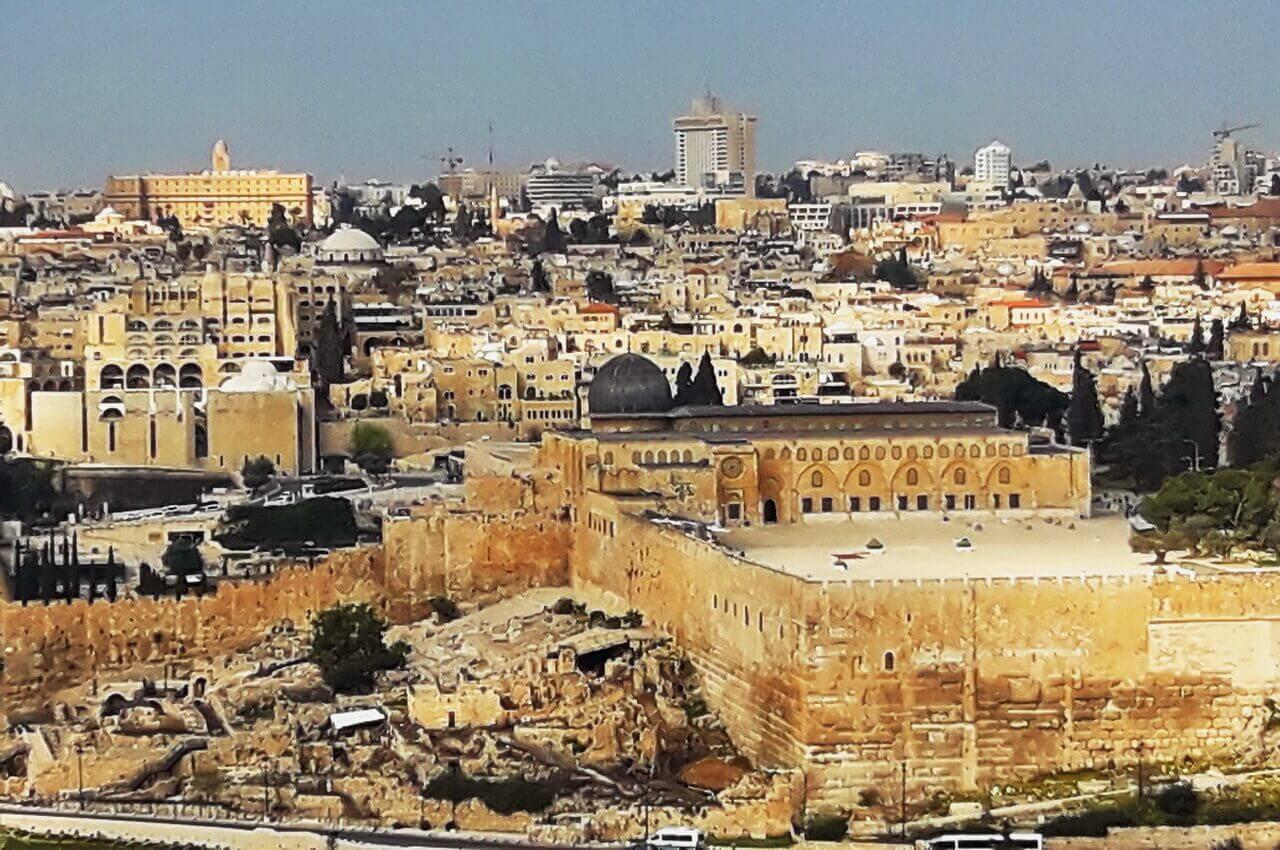
Silver-domed mosque Al-Aqsa
The mosque was renovated by various dynasties. Crusaders have used it as a royal palace and the headquarters of the Templar Knights. The Old City is under Israeli control, but the mosque is under the Jordanian/Palestinian-led Islamic Waqf.
Useful information:
Generally, non-Muslims may not enter the Dome of the Rock and Al-Aqsa mosque.
Muslims can visit them and pray as well every day. If you are planning a visit, first ask the tourist centre about the conditions and working hours. The best and safest way to visit Temple Mount is with guided tours because of restrictions.
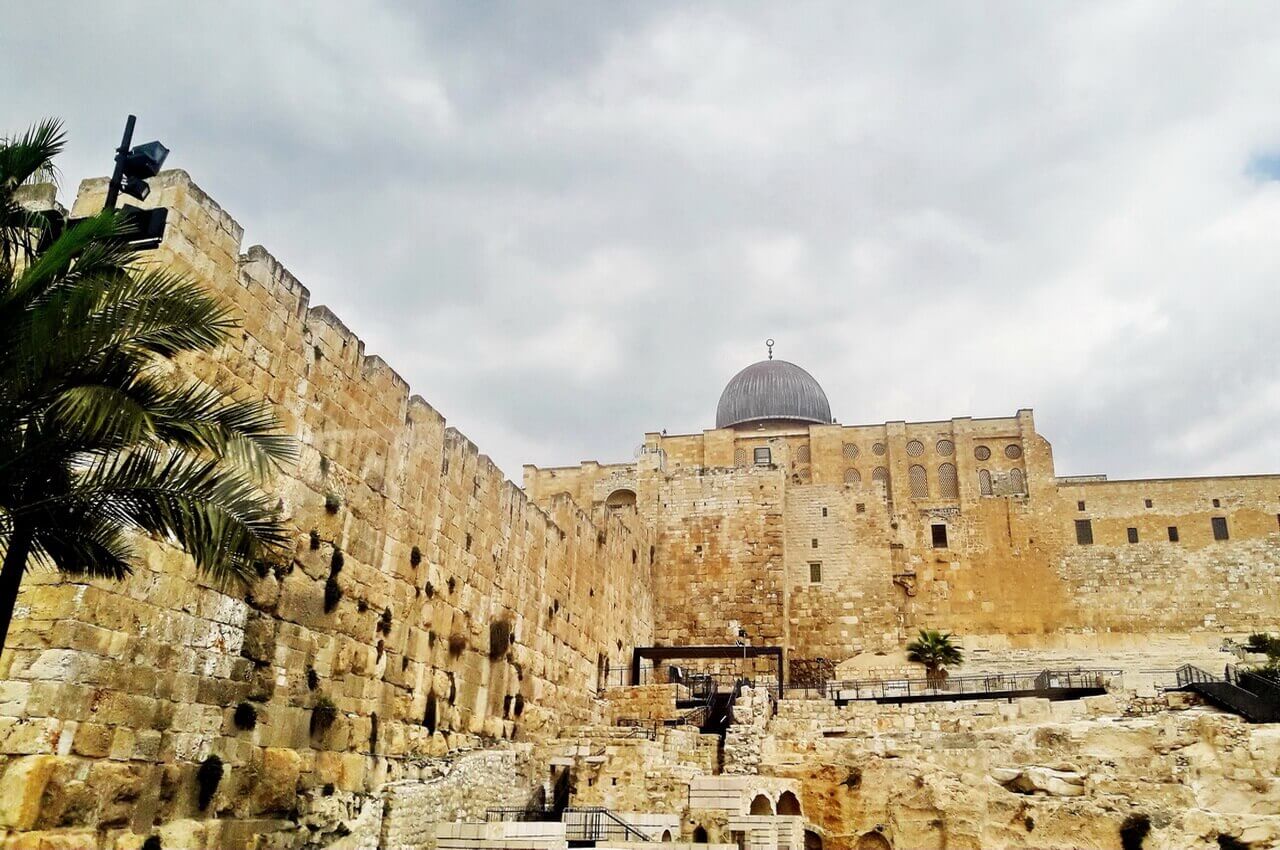
The walls around the Al-Aqsa mosque
Christian Quarter
The Christian Quarter is situated in the northwestern corner of the Old City. There are about 40 holy places for Christians, but the most important is the Church of the Holy Sepulchre.
It was built in the 320s AD under the Roman Emperor Constantine the Great and his mother Helena, in the place of the former Roman temple. The church was damaged and restored several times, as well.
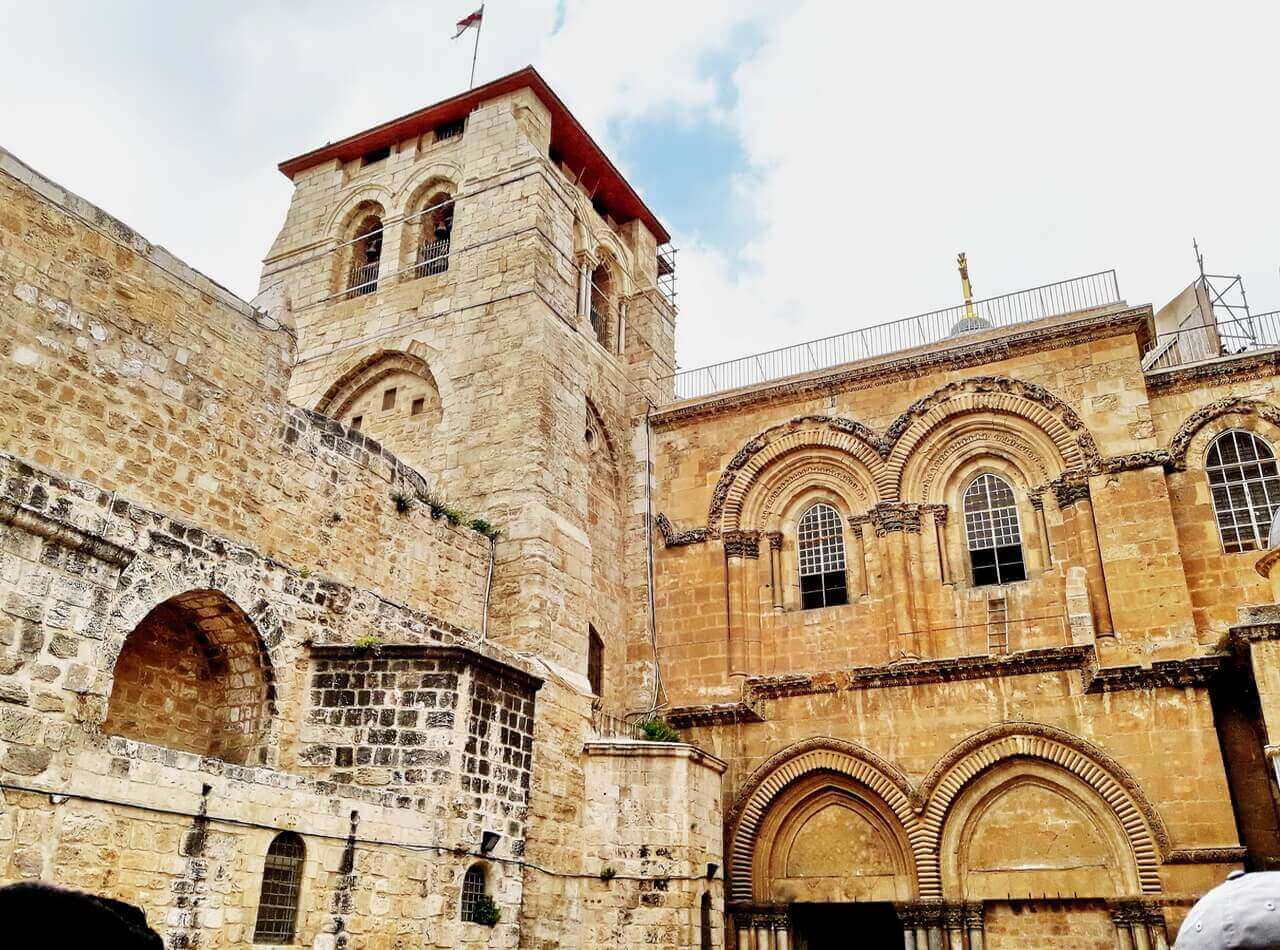
Frontal view of the Church of Holy Sepulchre
The church is the most sacred place, both for Catholic and Orthodox Christians because of two things.
First, it is the site where Jesus was crucified at a place known as Calvary Hill or Golgotha. And the second, in the centre, there is a little chapel Aedicule, with Jesus’ empty tomb, where he was buried and resurrected.
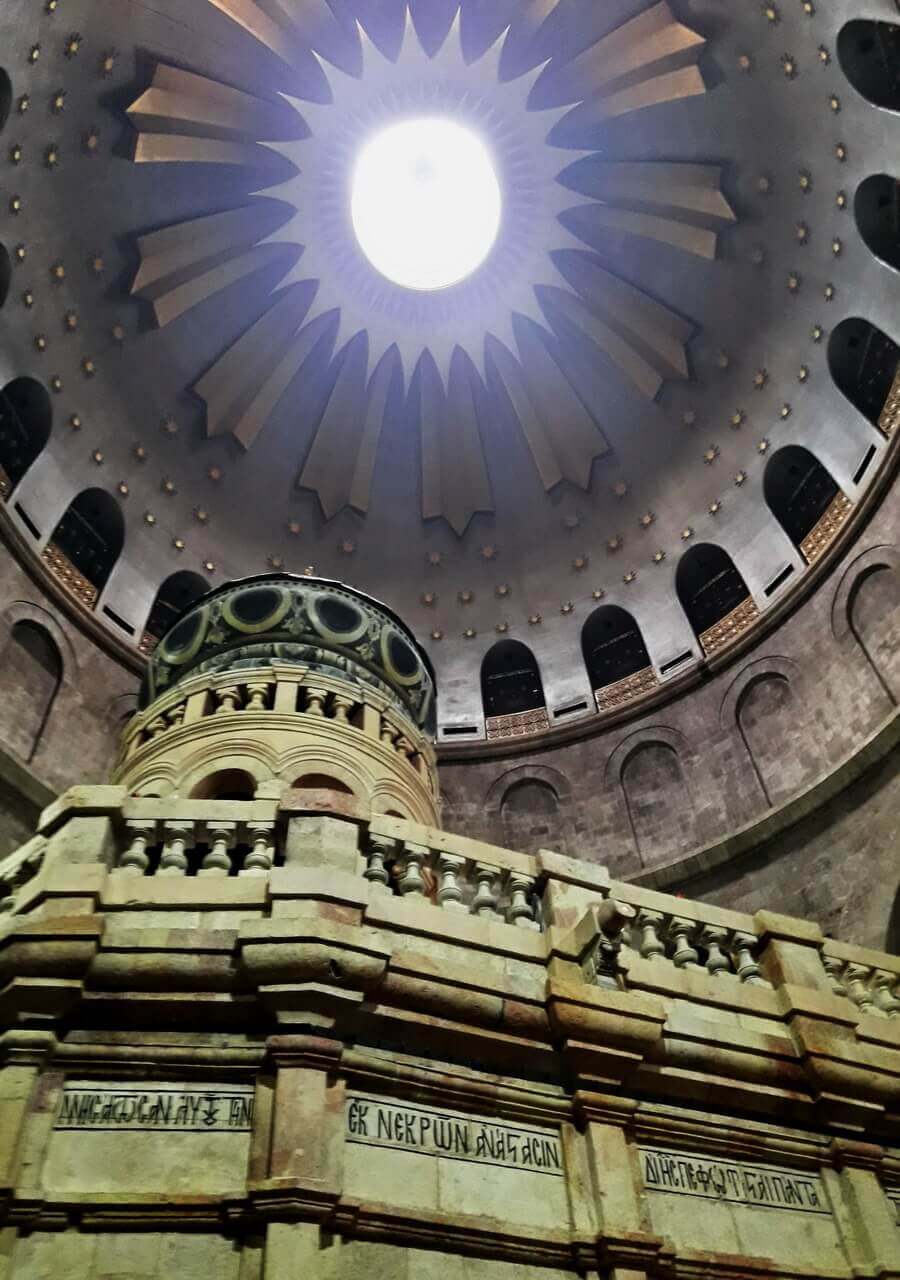
The Dome of the Anastasis above the Aedicule
However, the entire church complex is the headquarters of the Greek Orthodox Patriarch of Jerusalem, Roman Catholic, Armenian Apostolic, Coptic Orthodox, Syrian Orthodox, and Ethiopian Orthodox, as well.
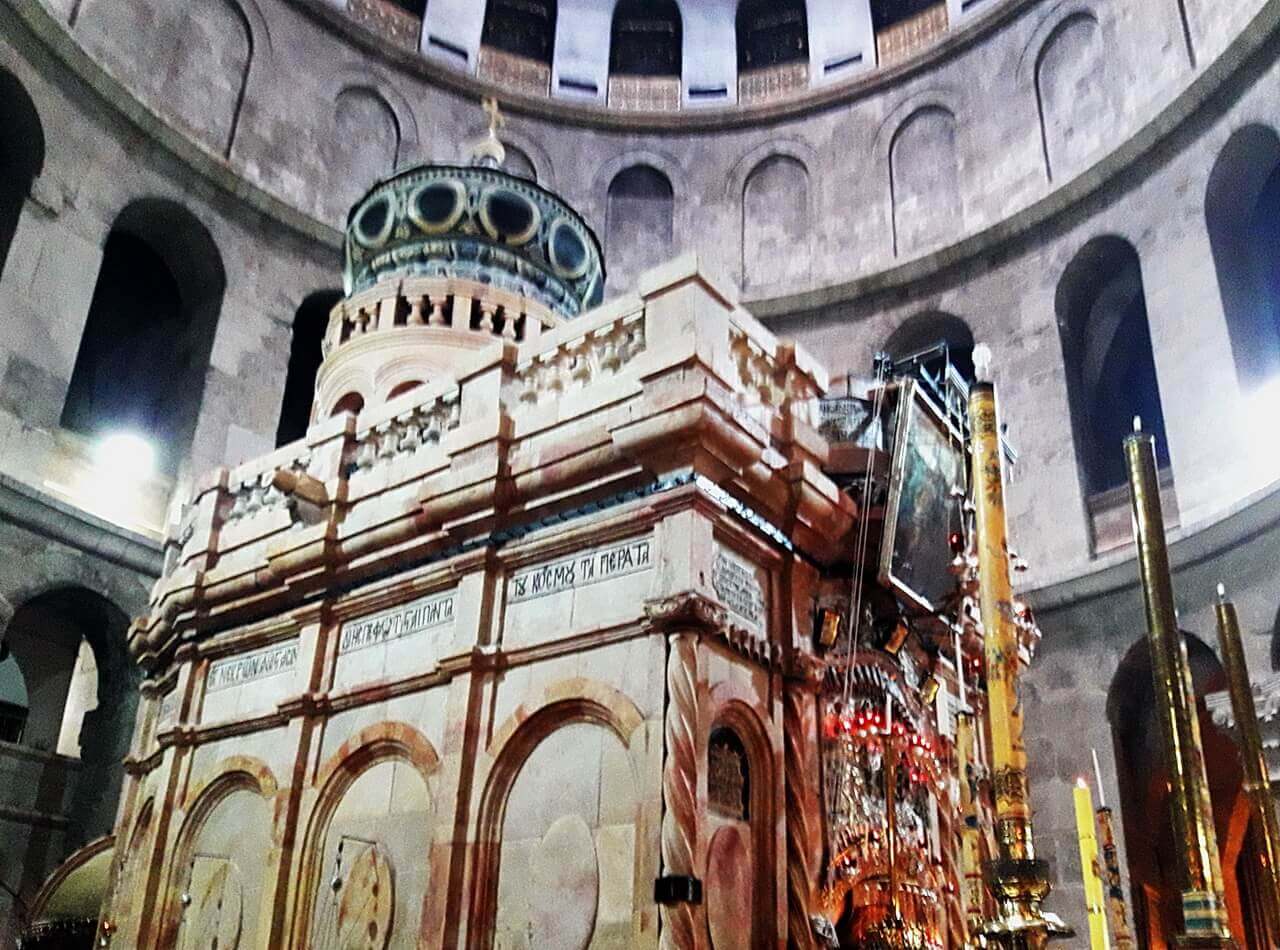
The Aedicule, The Church of the Holy Sepulchre
The Muristan area
Inside the Christian quarter, there is the Muristan area, which includes the Aftimos market and the German Church of the Redeemer. A market is a crowded place with many shops selling souvenirs, clothes, jewellery, carpets, and leather products. Also, you can take a coffee or eat something at the small restaurants in the market.
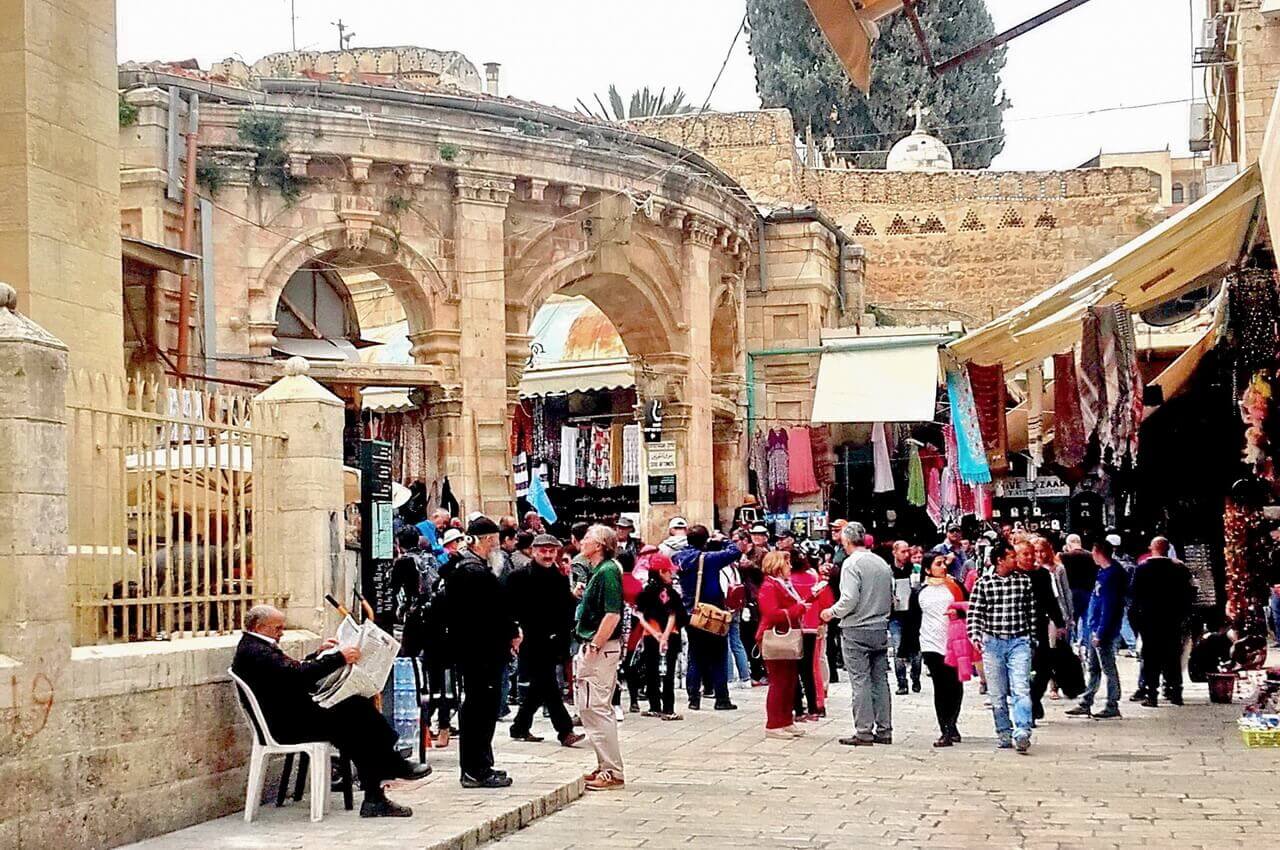
Jerusalem, Muristan, Christian Quarter
The Muristan name is derived from the Persian word for “hospital”.
During the 12th and 13th centuries, it was the site of the first hospital of the Knights of St John of Jerusalem, one of the most important military orders of the Crusaders. Today there is one marble memorial tablet as a reminder because there are no remains of the old hospital.
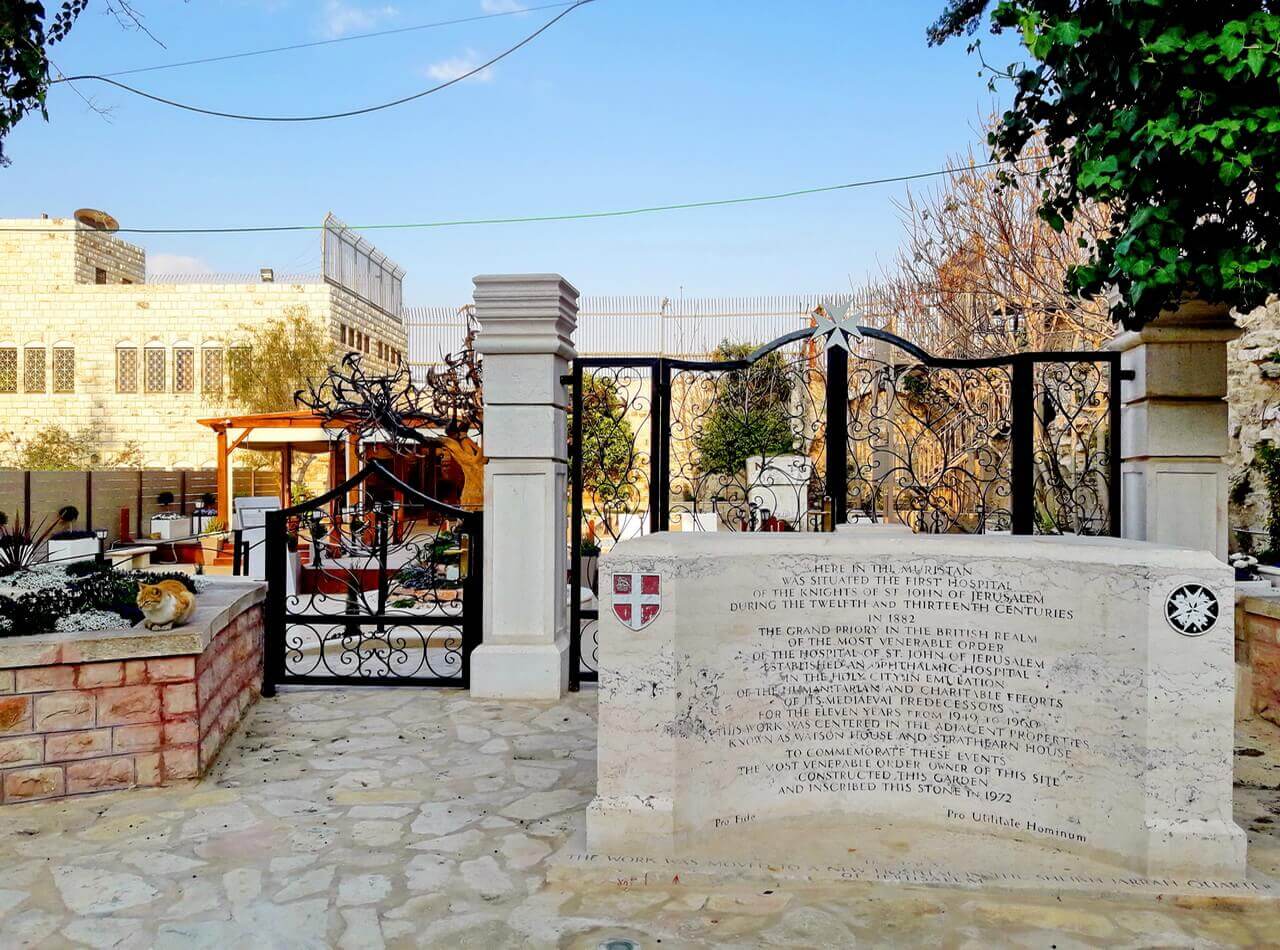
The former place of the first hospital of the Knights of St John of Jerusalem during the 12th and 13th centuries
Via Dolorosa in Jerusalem
Also, for Christians is very important Via Dolorosa.
It is the path that Jesus walked with the cross on his way to the crucifixion. It consists of 14 stations, which means 14 Jesus stops. Although most scientists think that it can’t be this route, “Via Dolorosa” or “Way of Sorrows” is filled with pilgrims and tourists all day. Each station is marked along the Via Dolorosa by a plaque on the stone walls and various chapels or sculptures. The last five stations belong to the area of the Church of the Holy Sepulchre.
More about Via Dolorosa stations and the Church of Holy Sepulchre you can read in the following post here.
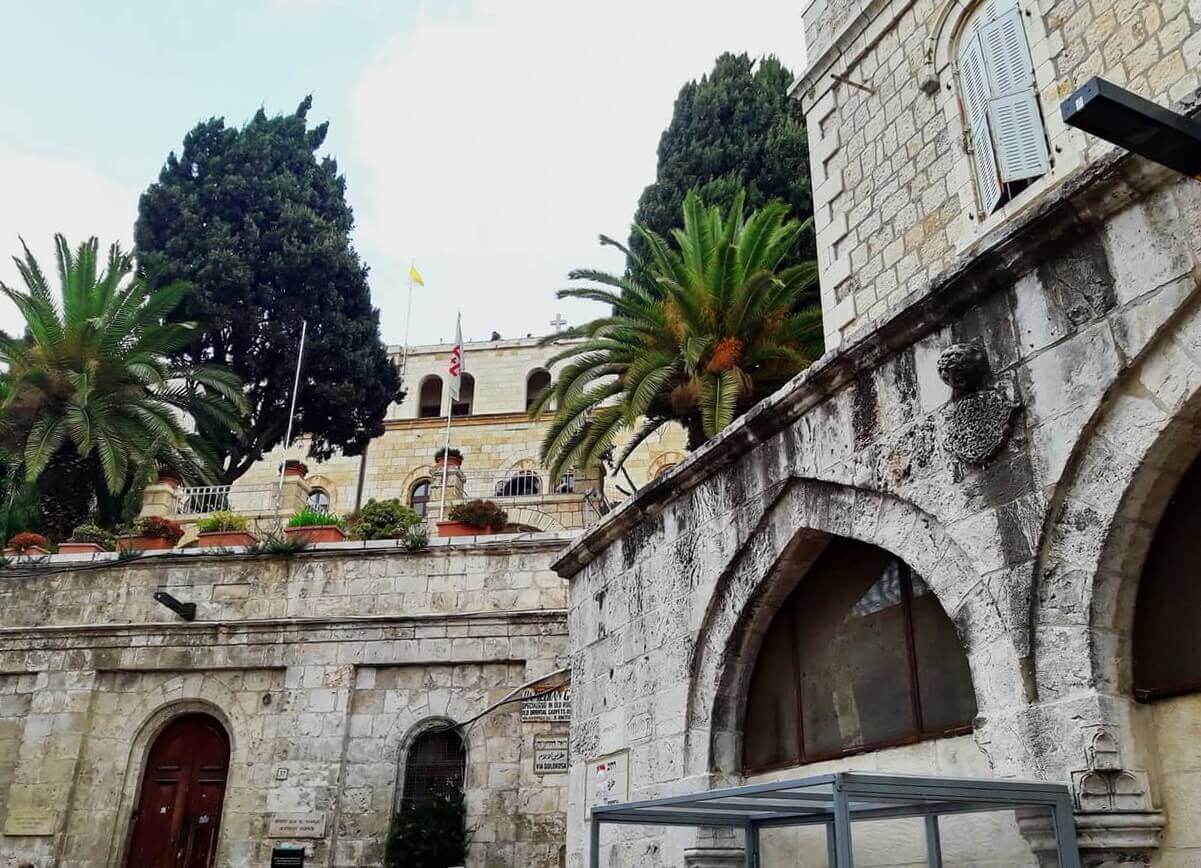
Via Dolorosa
Jerusalem, the stone city
Well, I have mentioned some of the most important sites to see and visit in Jerusalem. But there are more, of course. So make a plan about what you want to see, or just wander along narrow alleys with many little restaurants and shops with souvenirs, icons, crosses, menorah, the stars of David, spices, and clothes.
Get lost in the crowd with pilgrims, nuns, priests of all races, armed Israeli soldiers at every corner of the city, kids, and locals.
Whether you are there as a tourist or you are of Christian, Jewish, or Muslim faith, visiting Jerusalem is a special and unusual experience. This city of stones can’t leave anyone indifferent.
In the Bible, it is mentioned that “Anything is possible for the one who believes”.
So, only you can decide and choose what you believe in.
Every place on our beautiful planet has its own story.
But some have many of them. And definitely, Jerusalem has so much to tell us.

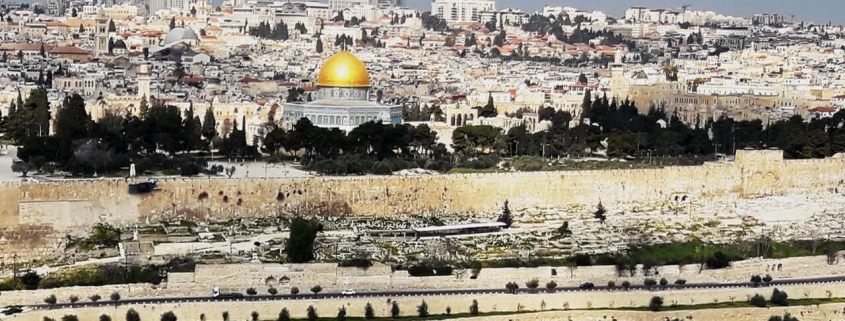
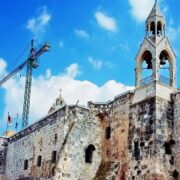
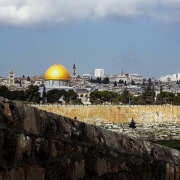 www.nataniatravel.com
www.nataniatravel.com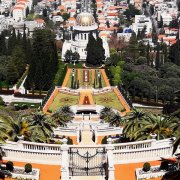
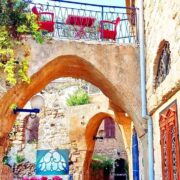
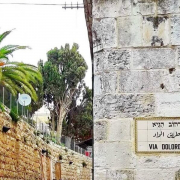

Trackbacks & Pingbacks
[…] is located on the central West Bank under Palestine rule. It is about 10 km (6.2 miles) south of Jerusalem, one of the oldest and holiest cities in the […]
[…] You can read more about fascinating Jerusalem here. […]
Leave a Reply
Want to join the discussion?Feel free to contribute!